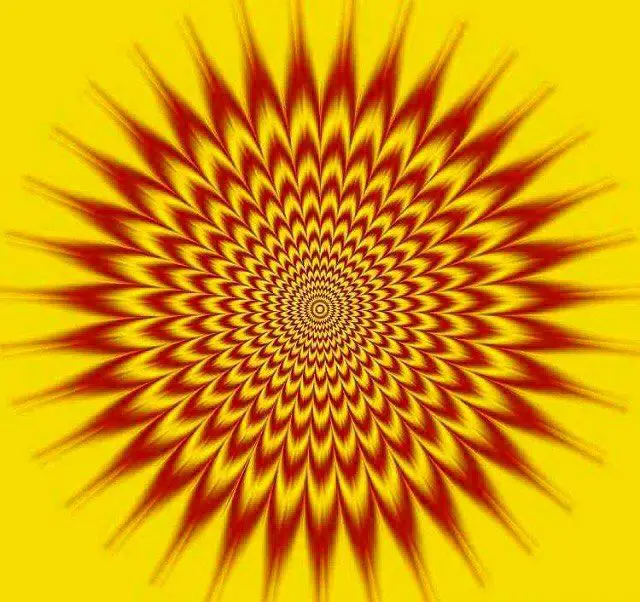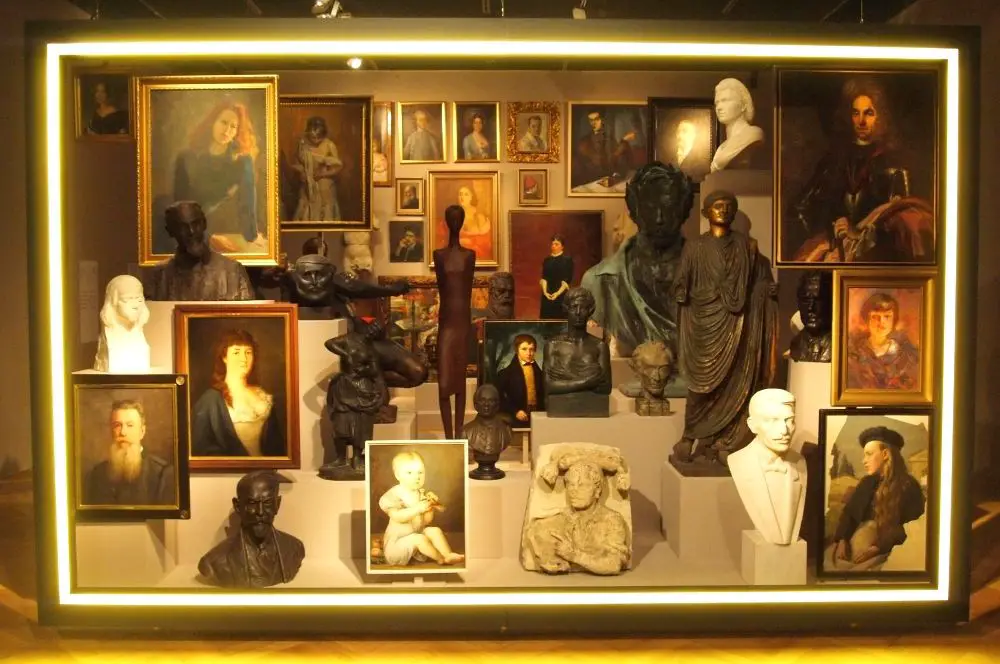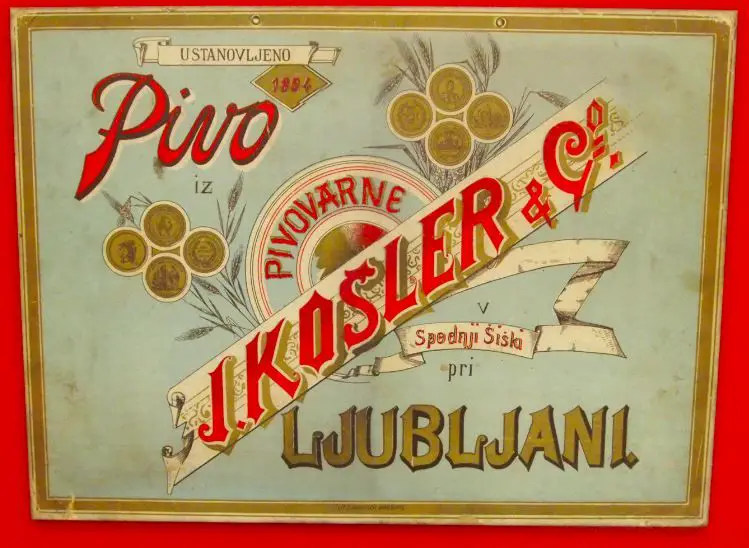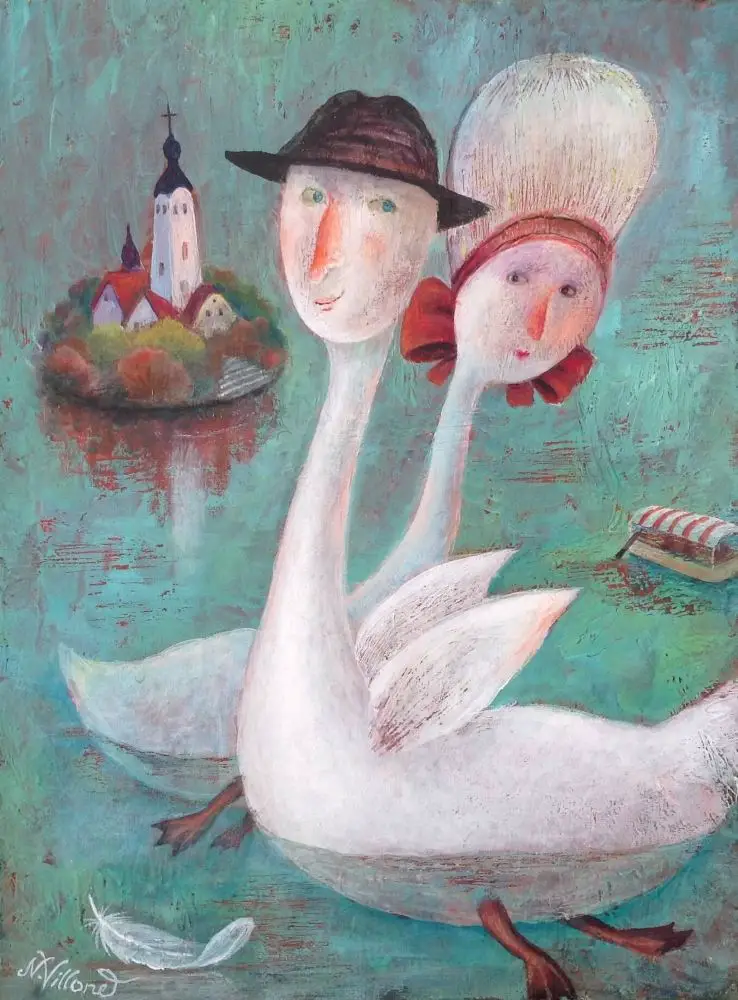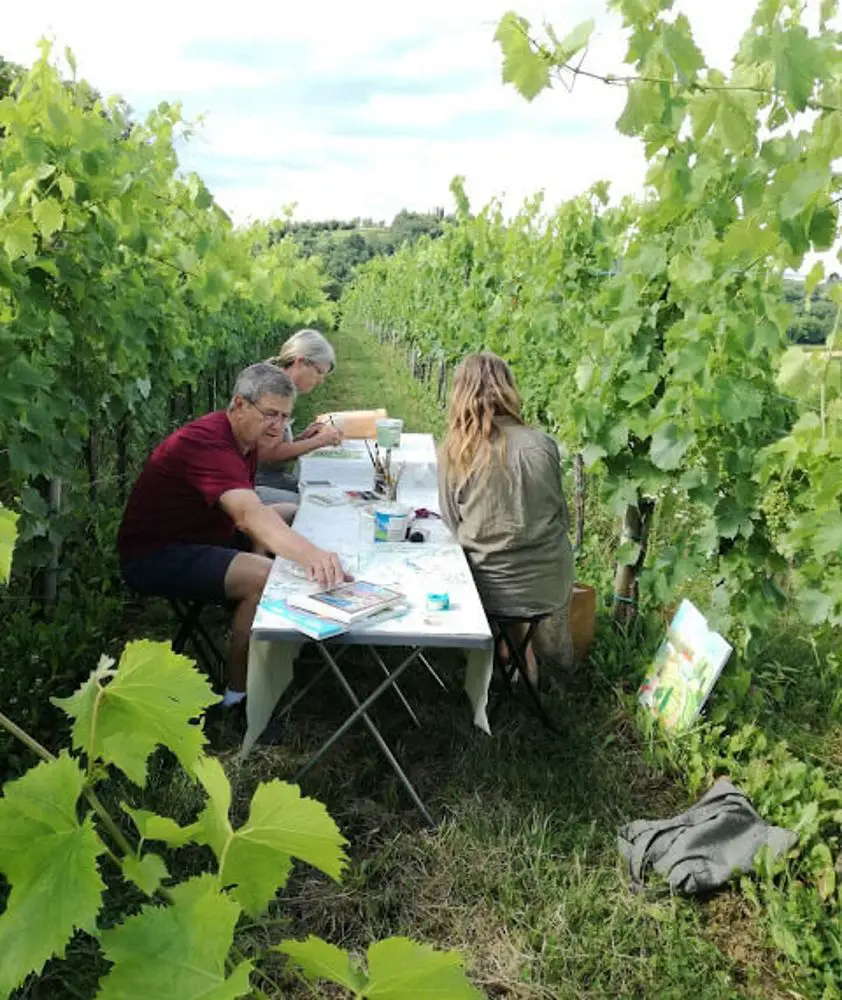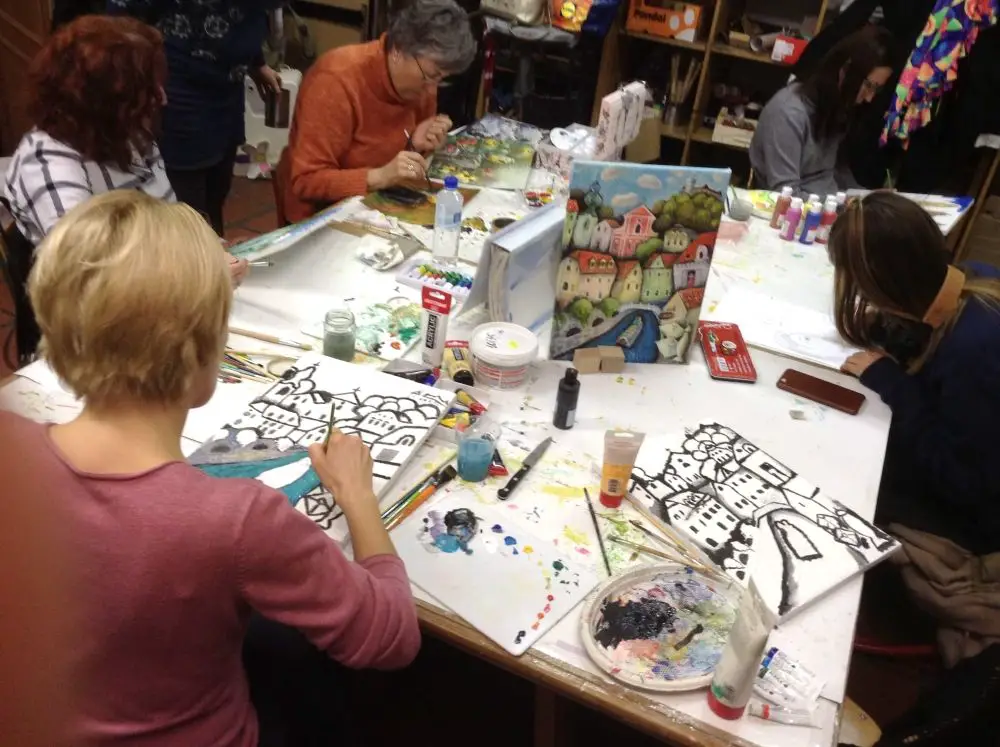News
STA, 14 January 2019 - Slovenian cyclist Janez Brajkovič announced on his blog on Monday that his sample taken during last year's Tour of Croatia had tested positive for a banned substance, earning him a ten-month suspension from the International Cycling Union (UCI).
The 35-year-old from Metlika handed over the sample, which tested positive for methylhexanamine, on 18 April 2018 as part of the main men's cycling stage race in Croatia, which is a part of the UCI Europe Tour.
The sample reportedly contained an extremely low level of the stimulant and energy-boosting drug, which the member of the Slovenian professional cycling team Adria Mobil believes is connected to his use of food supplements.
The Slovenian did not appeal the test results, while attributing the failed test to one of the food supplements he consumed being contaminated with the drug.
Admitting that the substance is banned in professional cycling, Brajkovič said it was a "small quantity, because as far as I know the concentration was 20 to 40 times lower compared to samples of other athletes," he said on the blog.
"I could fight this and bring the case to the anti-doping court, where it would be reviewed right from the beginning. But to be honest with you, I neither have the will nor the money to challenge this, which is why I have accepted the penalty."
In addition to being the world under-23 time trial champion in 2004, Brajkovič's biggest achievements include wins at the Criterium du Dauphine (2010), the Tour de Georgia (2007) and the Tour of Slovenia (2012).
He was ninth at the Tour de France in 2012 as a member of Astana Pro Team, which was the best ranking for a Slovenian until Primož Roglič finished forth last year.
Brajkovič, who was also a member of the professional teams Bahrain Merida, RadioSchack and Discovery Channel, said that testing positive for doping was not actually the worst thing that had happened to him in his career.
"I was a victim of mobbing and an outcast in a team because I did not want to expose myself to the deadly consequences of doping.
"During the Tour de France, a team mate even started strangling me because of this. After I signed the contract, they said I was nobody and valueless and that they will make sure I never race again."
Adria Mobil, which Brajkovič represented at the Tour of Croatia, said it had been informed about the positive test last July, but added that it did not need to suspend the cyclist under the anti-doping rules.
"Considering the quantity and type [of the substance], there was no direct and immediate suspension of the cyclist. Under an agreement with the competitor and the UCI and under the team policy on doping, Brajkovič has not competed since last July," the team said in a press release.
"The competitor has been cooperating with the UCI all the time in proving the origin of the banned substance found in his sample," it added.
Adria Mobil, which did not extend its contract with Brajkovič, noted that the cyclist had proven the failed test was a consequence of his carelessness. He purchased the food supplement on-line, and the label did not say that it contained the banned substance.
The usual penalty for such violations is a 24-month ban, but the UCI has reduced it to ten months due to these circumstances, the team said, adding that only the result from the Tour of Slovenia would be deleted from his record.
STA, 14 January 2019 - After a controversial rape case prompted calls for legislative changes in Slovenia, Justice Minister Andreja Katič told TV Slovenija last night she personally favoured defining rape by absence of consent.
The Slovenian penal code defines rape as a perpetrator coercing the victim into sexual intercourse by means of force or serious threats.
Related: Shock Case Shows How Coercion Defines Rape in Slovenia, Not Lack of Consent
Calls for amending the code intensified last week in wake of reports that a man from Koper who raped a drunk woman while she was asleep was given a milder sentence after being charged with criminal coercion rather than rape.
Commenting on the issue on the main news show on TV Slovenija last night, Katič said that for her personally rape was when the victim did not say yes.
She said that while the penal code had seen several amendments in recent years, the Justice Ministry had so far not received any initiative for a change.
However, when the public controversy broke over the Koper rape case, she called a meeting on how to amend the penal code, which will feature various stakeholders, including representatives of the prosecution, judges and NGOs.
She said that the meeting should look into various options, including the possibility of introducing the yes-means-yes principle because the victim might be too frightened or unable to say a clear no.
Escape from Koper jail
Katič also commented on the daring escape from the Koper prison, which a probe found was due to slack security with media reporting that the prison guards who were supposed to exercise surveillance were asleep, thus enabling two detainees to escape in late December.
Katič commented that those responsible were "lulled into the feeling that it's impossible to break from the prison", a feeling to which work at all levels was adjusted.
The minister said that Slovenian prisons were safe, also in comparison with other countries. She believes though that all security mechanisms should be checked and whether everyone was doing their job properly.
"What I have in mind is surveillance cameras and everything else as well as justice police officers and prison management," she said.
However, Katič also said that the prison break showed that additional justice police officers were needed. "We have a meeting with the ministries of justice and public administration on the topic on Tuesday, prompted by the prime minister."
With less than two months to go before Article 50 expires and the UK leaves the EU, which is currently set to happen at midnight on March 29, with or without a deal, the post-Brexit status of British nationals in Slovenia remains unclear. In recent weeks the governments of France, Spain, the Netherlands and others have all offered to guarantee the rights of British nationals, if the same safeguards are applied by the UK government to their citizens in Britain. As yet, however, no such announcement has been made by the Slovenian government.
Related: How to get dual nationality in Slovenia
We got in touch with the British Embassy on Friday, January 11, to ask if there were any ongoing discussions on this issue. The office replied later that day, but the response offered little comfort to those, like your correspondent, who are British nationals. We were directed to the call on Twitter by Robin Walker MP, Minister at the Department for Exiting the EU, for member states to set out their plans for reciprocal arrangements on Britons in the EU, and EU nationals in Britain, as seen below.
Minister @WalkerWorcester sets out the #UK's guarantees for #EU citizens in all scenarios, welcomes similar commitments from member states and calls for the remaining #EU countries to set out their plans to protect citizens. pic.twitter.com/XYXQkbIbaK
— Department for Exiting the EU (@DExEUgov) January 11, 2019
We were also told “Discussions are ongoing with the MZZ (Ministrstvo za zunanje zadeve – the Ministry of Foreign Affairs) regarding citizen's rights in the instance of a no deal scenario. We will continue to provide updates on this through our media channels [such as Facebook] but remain positive about UK resident's rights in Slovenia should there be a no deal.”
We were also advised to follow all the latest information on citizens’ rights is in the Embassy’s guide to living in Slovenia (here).
In short, with 74 days left until Brexit, and Theresa May’s deal likely to be rejected by Parliament later this week, British nationals in Slovenia can only wait and see what happens next, relying on the good will, and attention, of the Slovenian government to act soon and protect their current status, and the British Embassy’s continued optimism that it’ll all be OK in the end.
All our posts tagged “Brexit” can be found here
STA, 14 January 2018 - The party of Prime Minister Marjan Šarec has gained ground in the latest poll run by the newspaper Delo to reduce the gap separating it from the top ranking opposition Democrats (SDS) to 2.3 percentage points.
Having dominated the rankings for more than half a year, the SDS lost almost two percentage points from the month before to 16.2%, whereas the Marjan Šarec List (LMŠ) jumped more than 5 points to 13.9%.
This means that the margin between the SDS, the plurality winner of the June general election, and the runner-up LMŠ was reduced more than four-fold from ten points in December.
The Left, the government's partner in the opposition, trails at 6.8%, which is roughly level with the month before, but the party has advanced from fourth to third.
This was as the Social Democrats (SD) slipped back from second to fourth spot after losing four points to 6.5%.
Our guides to most of Slovenia’s many political parties can be found here
Delo notes that this is the first time since the June election that the poll has showed major differences in rankings between the five coalition parties.
The Modern Centre Party (SMC) of Foreign Minister Miro Cerar has lost over one percentage point to 3.7%.
The opposition New Slovenia (NSi) ranks fifth on 5.4%, 1.2 points up from the month before, followed by the National Party (SNS) on 4.1%, up 0.9 points.
Meanwhile, the Alenka Bratušek Party (SAB) and Pensioners' Party (DeSUS) changed places so that the SAB now polled at 3.4% and DeSUS at 2%.
The non-parliamentary People's Party (SLS) lost 2.5 points to 3%.
The proportion of undecided increased to more than a fifth (21.2%) with a further 7.1% saying they would not vote for any of the parties and 2.6% not wishing to answer the question.
The voter approval rating for the government and parliament also improved to 3.09 and 2.81 on a scale of one to five, from 3.01 and 2.72, respectively, the month before.
President Borut Pahor continues to top the ranking of the most popular politicians ahead of PM Šarec and EU Transport Commissioner Violeta Bulc.
NSi leader Matej Tonin advanced to fourth while SD leader and parliamentary Speaker Dejan Židan slipped a point to sixth. SAB leader Alenka Bratušek trails in 14th, Cerar in 15th and DeSUS leader Karl Erjavec in 20th.
Commenting on the increasing approval ratings for Šarec, the government and now also Šarec's list, Delo attributes them to low expectations for the minority government at the start of its term.
"Distribution of public funds which many feel in their pockets has made an impression. Higher are social benefits, minimum wages and per capita municipality income," Delo comments ion the front-page commentary.
"Almost 700,000 public employees have at least 4% more and many hope for more yet. White collars, who take the credit for the Cerar government ending its term early, are happy for the time being.
"However, the real challenges that will show what the government is made of are yet coming. The first ones will be the supplementary budget, healthcare, preparations for a pension reform and when we have to show how we are in fact prepared for the economy's cooling."
The poll was conducted by Mediana among 743 respondents between 3 and 10 January.
STA, 12 January 2019 - After three months in office, Culture Minister Dejan Prešiček has told the STA that the Slovenian culture sector is successful and comparable with the production on the global scale despite the incomparable infrastructural and financial circumstances in which it functions. He would not change the culture financing model drastically.
"We are successful in all artistic fields. Music production is top-notch, theatre as well. We have individuals who have achieved world renown. This is positive and I'm very happy about the fact that there is a creative drive," the minister said in an interview.
The other thing is that those who work in their own country sometimes work in very difficult conditions compared with global production, which is also better financed, but nevertheless Slovenian artists keep making top achievements, he added.
As a minister, he sees his role in improving these conditions, but he is not inclined to making "major shake-ups" of the culture financing model.
"The system as it is should not be drastically changed. My opinion is that it needs to be only evaluated, and we should find out what is good and what does not function, and what is perhaps somewhat obsolete," Prešiček said in comments that are likely to sit uneasy with freelance artists, who have complained for years about inadequate financing.
He believes, however, that Slovenia lacks a clear strategy of development of culture. "In order for institutions to function well, we need standards, including for costs," he said, adding that talks about that were already under way.
Asked about the criteria for awarding the formal status of an artist, Prešiček said that artists provided society with such an added value that one could not say that there were too many of them.
"Artists think, they are critical of society and contribute to its development. Their social status and how much money the state earmarks for them is another question," he said, adding that the state could perhaps be stricter in awarding statuses, which sometimes come with paid social contributions.
Regarding the situation in culture, he said that with the technological and social progress, arts were being changed significantly as well. "For some arts adjusting to the new social circumstances is easier, for others it is harder."
The minister is convinced that the existing model of financing of culture could be an example to many countries with larger financial potential considering the importance of culture in society and the results it scores.
But Prešiček thinks that it is "so fragile" that hasted and major changes would bring more harm that benefits.
According to him, there is no shortage of ideas and tasks for the four-year term, which include the status of members of non-governmental organisations and self-employed culture workers, with which the state "has failed to deal with at the systemic level".
The idea is to regulate this with a special law, he said, adding that the bill prepared by the opposition Left could serve as its first draft.
Talks with Prime Minister Marjan Šarec and Finance Minister Andrej Bertoncelj and within his party, the Social Democrats (SD), suggest that there will be some more money for culture in the emerging supplementary budget for 2019, he said.
"Culture should not be perceived as a cost, but as an investment and added value both in the economy and tourism. It is a global trend and we are also adopting it. You cannot offer only mountains and water to a tourist, but also content and a story."
When it comes to legislation, Prešiček announced for February a public debate on changes to the media act, which he said would be adapted to the current technological environment.
"The planned change which will probably be most controversial politically will be prohibition of instigation of inequality and intolerance and measures when something like this happens. Sanctioning violations is something completely normal in all democratic societies," he said.
Below is a review of the headlines in Slovenian dailies for Monday, January 14, 2019, as summarised by the STA:
Migrant crisis in Bosnia
"EU is turning western Bosnia into a human dump": Western Bosnia-Herzegovina turned into a bottleneck last year when it comes to the migrant crisis, with some 6,000 migrants still looking for ways to get across the border with Croatia and further west. (front page, 6)
Party rankings
"LMŠ separates itself from the partners": The opposition Democrats (SDS) leads the latest public opinion poll conducted by Delo with 16.2%, and is closely followed by the LMŠ party of Prime Minister Marjan Šarec with 13.9%, which is by far its greatest result since the June 2018 election. (front page, 2)
Heavy snow in Austria
"Austria still under great risk of avalanches": Three German skiers were killed by an avalanche in the Austrian ski resort of Lech as they took a closed route, while the fourth one is still missing. The western states of Tyrol and Vorarlberg are still under a high snow slide alert. (front page)
DNEVNIK
Migrant crisis
"Police appeals against information commissioner over migrants": The police have filed an appeal against the decision of the information commissioner that they need to reveal the documents on the treatment of migrants on the border with Croatia. (front page, 6)
Ljubljana infrastructure
"Rakova Jelša to be protected by embankment": The illegally constructed residential buildings in Rakova Jelša on the southern outskirts of Ljubljana, which were legalised in 1994, are still under risk of flooding. The municipality is now planning to build an embankment to protect the southern part of the suburb. (front page, 9)
Macedonia name change
"Greek coalition breaking up because of name change": Greek Prime Minister Alexis Tsipras has called for a confidence vote in parliament after the Independent Greeks (ANEL) announced it was pulling out of the coalition as it opposes Greece's naming deal with Macedonia. (front page, 6, 16)
FINANCE
Acquisitions
"Battle for Hidria": A battle for ownership of the automotive and industrial technology conglomerate Hidria is under way, with executives Iztok Seljak and Dušan Lapajne publishing a takeover intent for all shares of H&R, the firm controlling Hidria and owned by the Svetlik family. (front page, 4-5)
Real estate market
"Seven factors which will affect prices of apartments in Ljubljana": The paper lists three factors which could increase the prices of apartments in Ljubljana, including growth of tourism, and four factors which could decrease the prices, including more expensive loans. (front page, 2-3)
VEČER
Energy
"One TEŠ already paid for": The paper analyses the planned centralisation in the Slovenian energy sector, expressing concern over the power producer Dravske Elektrarne Maribor (DEM) losing jobs while the headquarters of the owner HSE tripling the number of employees. (front page, 3)
Sport
"Not all that glitters is gold? It is!": Maribor is still a sports city although the perennial football champions from the city did not defend their title last year. The women volleyball players and male bowlers and chess players have brought the national titles to Maribor. (front page, 20)
Macedonia name change
"Fight for name continues": The Macedonian parliament has confirmed the constitutional change of the country's official name to the Republic of North Macedonia, now the support on the Greek side is questionable. (front page, 2)
January 13, 2019
A fire broke our on the first floor of a building in the premises of the former Rog bicycle factory, now known as the “Rog Autonomous Zone”, this Sunday morning, at about 2:00 am.
Unofficially the fire started in a room with a wood-burning stove in one of the buildings living quarters, then spread to other rooms and also damaged one part of the roofing. One person was taken to the University Medical Centre due to smoke inhalation.
The fire was extinguished by the firefighters of the Fire Brigade of Ljubljana and by the Voluntary Firefighters’ Society of Ljubljana.
Related Video: Inside Rog and Metelkova
STA, 12 January 2019 - Ten years ago Slovenia faced the onset of a major financial and economic turmoil and it was not until 2017 that the country's GDP returned to pre-crisis levels. However, even as some described the period as a lost decade, the economy has emerged from it healthier and more resilient to a potential new crisis.
Related Video: Slovenia's economic problems, 2012
After a few years of rapid expansion peaking at 6.9% in 2007, Slovenia's economy contracted by 7.8% in 2009 in the wake of the outbreak of a global financial crisis in what was one of the biggest slumps in the EU, after those in the Baltic countries and Finland.
After minor upwards corrections in 2010 and 2011, faltering domestic private and state spending and fast-falling investment led to two more years of economic decline, which was exacerbated by a deterioration in the banking sector and the financial market's growing distrust of the country.
The crisis bottomed in the third quarter of 2013 and Slovenia's GDP has been increasing ever since, accelerating up to the annual rate of almost 5%. The growth is estimated to have proceeded at roughly the same pace in 2018, after which it is expected to slow down to about 3% in the coming years.
Despite the accelerated growth seen in the past few years, real GDP did not return to pre-crisis levels until 2017, which means that the country needed almost a decade to come back to the point it departed from at the end of 2008.
A major domestic factor deepening the crisis was a slump in investment, both corporate investment and housing construction and major investments in road and rail infrastructure after a strong growth in the pre-crisis years.
Between 2008 and 2013, the value of construction work was more than halved, before increasing in 2014 driven by completion of EU-subsidised projects, only to fall yet again. It was not until 2017 and 2018 that the sector saw more sustainable double-digit growth rates.
The collapse in the construction industry caused many construction companies to go bust, including giants such as SCT and Primorje. It also paved the way for new and so far minor players to make a breakthrough in the field.
Real GDP growth (%) Real GDP per capita (EUR) 2008 3.3 19,200 2009 -7.8 17,500 2010 1.2 17,700 2011 0.6 17,800 2012 -2.7 17,300 2013 -1.1 17,000 2014 3.0 17,500 2015 2.3 17,900 2016 3.1 18,500 2017 4.9 19,400 * Reference year is 2010
Final household Gross capital General government
consumption formation final consumption
2008 2.6 7.0 4.9
2009 0.9 -22.0 2.4
2010 1.1 -13.3 -0.5
2011 0.0 -4.9 -0.7
2012 -2.4 -8.8 -2.2
2013 -4.2 3.2 -2.1
2014 1.9 1.0 -1.2
2015 2.3 -1.6 2.4
2016 4.0 -3.7 2.7
2017 1.9 10.7 0.5
Value of construction work (%) No. of construction jobs 2006 15.6 72,810 2007 18.5 82,140 2008 15.5 92,140 2009 -21.0 91,280 2010 -17.0 82,970 2011 -24.8 73,230 2012 -16.8 67,700 2013 - 2.6 62,960 2014 19.5 62,290 2015 - 8.2 62,550 2016 -17.7 61,930 2017 17.7 63,550
Source: Slovenia's Statistics Office, Eurostat
An even better indicator of the so-called lost decade is trends in GDP per capita and final individual consumption in purchasing power standards (PPS) as a percentage of EU, as two comparative indicators of a standard of living.
At the end of 2017 Slovenia trailed the pre-crisis level by both measures compared to the EU average. During that time, it has been overtaken by the Czech Republic among the new EU members, while Slovenia and the Baltic countries are catching up.
GDP per capita in PPP
(% of EU average)
2008 89.5
2009 85.1
2010 83.3
2011 83.0
2012 82.0
2013 81.6
2014 82.1
2015 81.8
2016 82.2
2017 84.0
Final individual consumption in PPP
(% of EU average)
2008 80.2
2009 79.9
2010 80.5
2011 80.8
2012 80.4
2013 78.1
2014 77.2
2015 76.5
2016 77.3
2017 77.2
Source: Eurostat
The crisis years and the post-crisis period have also produced some positive developments. The Slovenian economy has undergone a restructuring and boosted its competitive edge, so that exports recovered fast from the major contraction in 2009, and after an interim period of moderate growth, returned to strong growth in 2017. Exports at the end of 2018 are estimated to have outpaced those of 2008 by 50%.
Since exports have been increasing at a much stronger rate than imports, Slovenia also started to post a a trade surplus which (services included) in 2017 amounted to almost 10% of GDP and accelerated to 12% of GDP in the third quarter of 2018.
It was a key factor to the improvement of Slovenia's balance of payments and total economy balance. The latest available data indicate that Slovenia's economy posted a surplus of 9.1% of GDP in transactions with abroad in the third quarter of 2018.
The surplus has put the national economy on much healthier foundations, meaning it is no longer living beyond its means, but rather generates savings.
If Slovenia was a net debtor in the pre-crisis years, the banks settling their foreign debts and corporate deleveraging have turned the financial and corporate sectors and households into net creditors to abroad, so that the only net debtor remains general government, having taken out a great amount of foreign debt during the crisis.
Exports of goods and services Annual change (%)
(EUR bn)
2008 20.0 2.1
2009 16.3 -18.8
2010 18.6 14.6
2011 21.0 12.7
2012 21.1 0.3
2013 21.5 2.3
2014 22.9 6.4
2015 23.9 4.4
2016 25.0 4.3
2017 28.3 13.2
Balance of goods trade (EUR m) Total economy balance/
Current account balance
(% of GDP)
2008 -299.6 -4.8/-5.3
2009 -100.7 -0.2/-0.6
2010 -146.1 0.0/-0.1
2011 -155.6 0.0/0.2
2012 -101.7 2.2/2.1
2013 -565.4 3.6/4.4
2014 355.5 6.0/5.8
2015 635.1 5.6/4.5
2016 859.1 4.6/5.5
2017 658.8 6.3/7.2
Source: Slovenia's Statistics Office, central bank
The lights are down, the days are lengthening and the streets are rather empty, as Ljubljana moves into the dead zone between tourist seasons. But while this isn’t good for business it does offer fresh pleasures and new views to visitors and residents, who can now have a little more time and space to themselves in the downtown area. What’s more, there’s still plenty to explore and enjoy, with an incomplete selection of the more organised entertainments, distractions and events listed below, just after the basic information.
If you're reading this and not in town January 14 to 20, 2019, then you can see all the editions of these guides here, with the latest one at the top.
As ever, clicking on the venue names in the list below should get you more details with regard to the time, price and location, as well as other events on at this place in whatever week you're here. Finally, if there's something you want to promote in a future edition of What's on in Ljubljana please get in touch with me at flanner(at)total-slovenia-news.com
Getting around Ljubljana
If you want to get a Ljubljana Tourist Card, which gives you travel on the city buses and entry to a lot of attractions, then you can read more about that here, and if you want to use the bike share system, as useful for visitors as it is for residents, then you can learn more by clicking this. Visitors with reduced mobility will be pleased to find that downtown Ljubljana is generally rated as good with regard to accessibility, and that there’s a free, city-sponsored app called Ljubljana by Wheelchair highlighting cafés, attractions and so on with ramps, disabled bathrooms and Eurokey facilities, which you can read about and download here. If you’re driving into town and don’t know where to part, our guide to how to park in Ljubljana is here.
Want / need cigarettes but the stores have closed? Here's an incomplete list of bars downtown that will satisfy your craving for the demon weed. While if you’re having trouble with the ATMs then here’s a guide to the Slovene you’ll see on screen. If you get a hangover then find out where to get paracetamol (and prescription drugs) in Ljubljana here, while details on emergency birth control can be found here.
Ljubljana is a small and relatively safe city, but if need to contact the police then there’s a special number for foreigners, and that’s 113.
Cinemas and films playing in Ljubljana this week
You can read about all the cinemas in town here, while a selection of what’s playing this week is below, and note that kid’s movies tend to be shown in dubbed versions, so do check before driving out to a multiplex and dropping off the young ones if they can't understand Slovene. That said, parents should pay attention to Kinobalon, which is Kinodvor's regular weekend series of film screenings and events for children, from babies on up, with special parent/child events, "first time in a cinema" screenings, and babysitting. Learn more about it here, and see the current schedule here.
Kinodvor – The arts cinema not far from the train station is showing, among other features, The Old Man & The Gun, Maria by Callas, The House That Jack Built, Suspira (remake), The Favourite and The Incredible Story of the Giant Pear (dubbed).
Kinoteka – This revival cinema isn’t far from Kinodvor, at the train station end of Miklošičeva, and it's showing a few Yugoslav movies this week, including Ubij me nežno, Draga moja Iza, Sedmina, Beograjski fantom and Ne čakaj na maj. There’s also Yi Yi from Taiwan, Le bonheur by Agnes Varda, and Lars von Trier’s Forbrydelsens.
Kolosej - The multiplex out at BTC City Mall is playing all the big movies, which this week include The Grinch (with both subbed and dubbed versions), Fantastic Beasts: The Crimes of Grindelwald, Bohemian Rhapsody, Robin Hood, Johnny English 3, A Star is Born, Gajin svet, dubbed and subbed versions of Spider Man: Into the Spider-Verse, Aquaman, Bumblebee, a dubbed version of Asterix: Le secret de la potion magique, Second Act, Mortal Engines, Južni veter, Mary Poppins Returns, Ralph Breaks the Internet: Wreck-It Ralph 2, and The Old Man & the Gun. New this week are The Favourite and The Upside.
Komuna – The cinema in a basement behind Nama department store is showing The Favourite, A Star is Born, The Old Man & the Gun, and Bohemian Rhapsody.
Skrbovni’ca – Bringing inclusion to the heart of Ljubljana
Whether you’re looking for a souvenir, small gift, some directions or a sit down, consider going into Skrbovni’ca when you’re next between the Triple Bridge and Town Hall, just opposite Vigo. It’s a project that aims to bring more physically and mentally disabled people into the community, and you can learn more about it here.
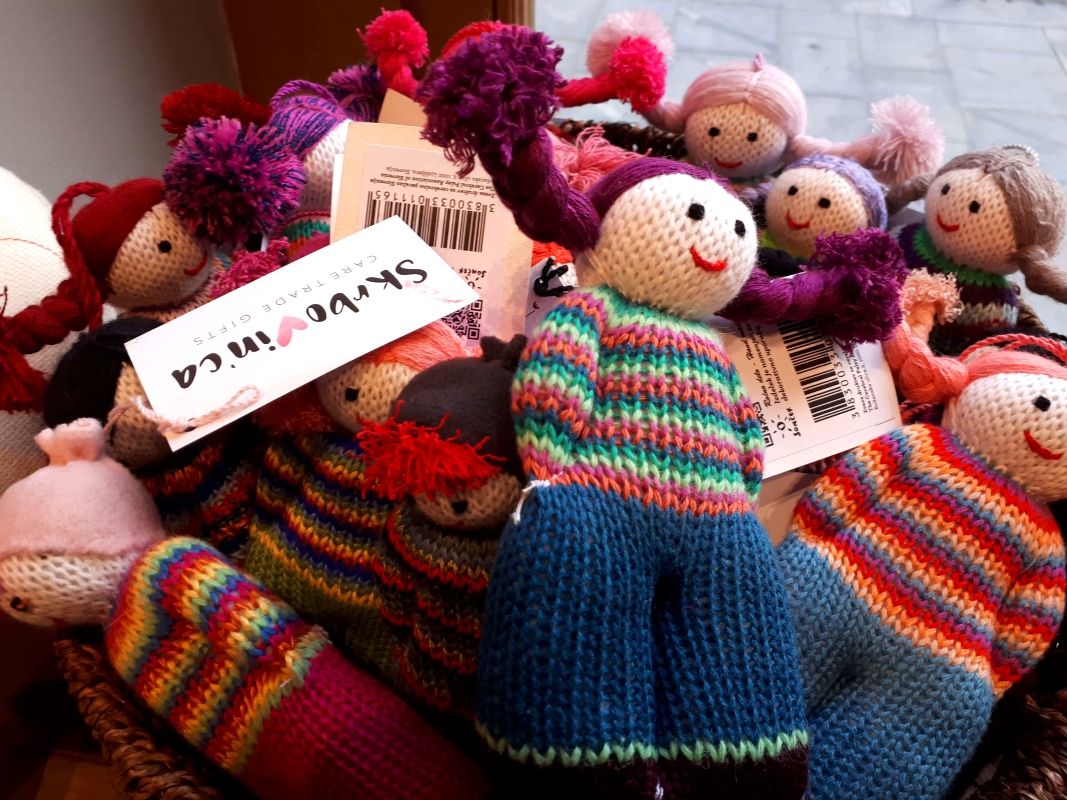
Photo: JL Flanner
Clubbing in Ljubljana
Compared to some European capitals it can seem that nightlife in Ljubljana ends rather early, especially along the river, but there are still bars that stay open late and clubs were you can dance until dawn, and perhaps the best place to stumble across something interesting is the legendary Metelkova. Be aware it's a grungy kind of place and not for all tastes, but also that there's consideable variety to found within the various clubs there, from death metal to electropop, gay caberet to art noise. You can read "the rules" of the place here.
Ambasada Rog – Friday night, at Trubarjeva 72, there’s Fight the power! Music of rebellion - Persian and Arab hip-hop.
Channel Zero – Monday night is Dub Lab, All Night Session: RollKing. There’s more dub on Friday, which brings Dubwise Massive! with Unlisted Fanatic, and Boris Sound System, among others.
Gala Hala – Friday night it’s Zeleno sonce 119: Russian Attack, with Dj SOUL-K and DJ Udo Brenner.
Klub Cirkus – Friday night the more commercial end of the klubland has New AGE / MILI, with trap, hip hop, and R’n’B from the New Age Gang and a live show from Mili. Saturday the dancefloor is then surrendered to TUTTI Frutti: 90s & 00s Hits, with DJs Matthew Z & Matteo Kunst.
Klub K4 – More than 30 years old and still going strong, on Friday you can enjoy Phi w/ DMX KREW Live! The next night it’s the turn of Just A Dance, with DJs Den7el, Von Meister, and Dulash (Kvalitat), along with VJ 5237.
>Harm reduction and drug testing
Drogart is an organization that aims to minimise harm on the party scene, and offers drug-testing services and reports on their webpage. It’s in Slovene, but you can Google translate it or work things out yourself, and our story on the group is here. They recently published a story warning about three pills with very high contents of MDMA, with details (in Slovene) here. Also be aware that all the usual drugs are illegal in Slovenia.
Some fun facts about the city and its castle...
Enhance your stay in the city and impress or annoy your friends and companions by learning some obscure facts about the city here, and the castle here.
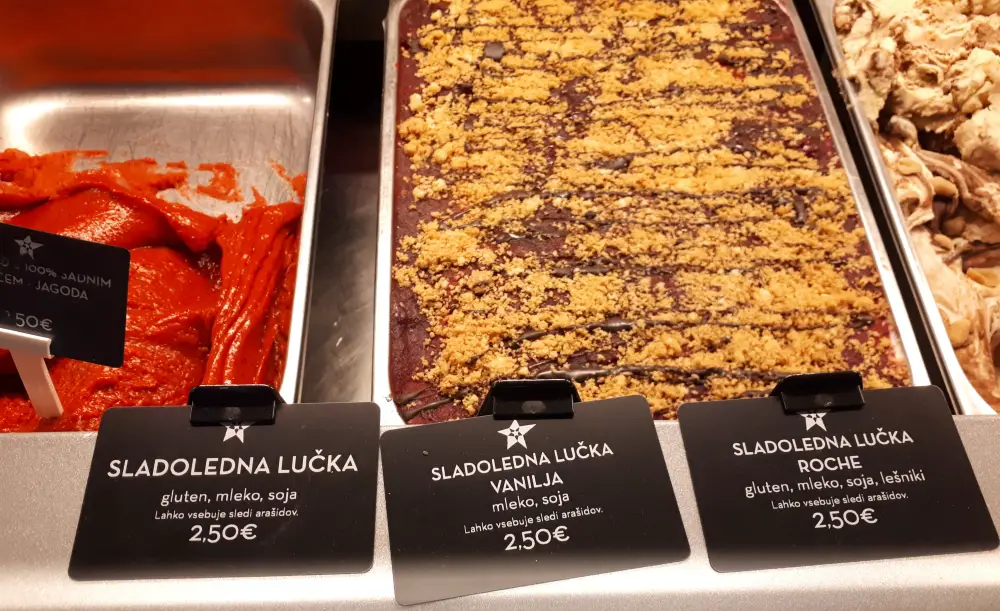
Photo: JL Flanner
Things to do with children in Ljubljana
You can find our Top 12 list of things to do with kids in Ljubljana here. If want to read more about the philosophy behind the wonderful House of Experiments look here, while our trip to the Museum of Illusions is documented here, and there’s always riverside walks, pizza and ice cream. With regard to the latter, take a look at our guide to six places that serve good ice cream in winter.
Mini Teater Ljubljana – The season sees a lot of puppet performances for children, in Slovene, at this theatre not far from Križanke, including: The Frog King, Puss in Boots, Carrot Dwarf and The Little Match Girl. The English schedule for the month is here.
Ljubljana Puppet Theatre - The puppet theatre near the Central Market and next to the Castle funicular has a full programme of shows, for children and adults, with the schedule here.
Photo: JL Flanner
Live music in Ljubljana
Channel Zero – Thursday, from 21:00 to 00:00 you can enjoy live avant-garde jazz with Bonus Level: Ottone Pesante + Koromač, with the former being described as “extreme Italian brass metal lunatics” and the latter as “mixing hardcore and metal with jazz”. Anyone interested in this should note that John Zorn will be in town this summer.
Gala Hala – Thursday, 21:00 to 00:00, there’s stoner rock with Domorodni četrtki: Blackoutt. You can see them playing live at the same venue last year, below.
Kino Šiška – Thursday “diligent folk punkers” We Bless This Mess are playing a show. Saturday it’s Same Babe, who will be presenting their new album.
Klub Gromka – Trobecove krušne peći, an avant-garde postpunk band from Zagreb, will be playing with support from Idrija’s S.O.R, a double-bill you can catch on Saturday.
Ljubljana Castle – Friday is jazz night at the Castle, and this week it’s the Ratko Divjak Quartet.
Orto Bar – Thursday there’s another Kadilnica of Death presentation, with power metal from Minotauro and HairX. Friday night it’s Dirty Skunks Fest, with Armaroth, Snogg, Teleport, Lintver, Valuk, Agregat and many others. The week ends on Saturday with a live set from Get Back, a tribute superband playing rock hits from the 60s and 70s.
Slovenska filharmonija – Thursday, the 17th, The Slovenian Philharmonic Orchestra will be joined by Matej Šarc (musical direction and oboe) and Tomaž Sevšek (harpsichord), playing music by three of the Bachs along with Graun and Krebs, with the featured work by the latter shown in the first video below. Friday there’s new music for the new year, with a programme of Pierre Boulez, George Benjamin, Matej Bonin, and Janez Matičič. The piece by Boulez is in the second video. Sunday, the 20th, Simfonični orkester RTV Slovenija will be playing Mozart and Haydn.
Opera, theatre and dance in Ljubljana
Cankerjev dom – Saturday there’s ballet, with Peer Gynt, as performed by the Ballet and Orchestra of the SNG Maribor Opera and Ballet. The next evening the Slovak Philharmonic and Slovak Philharmonic Choir will be performing Antonín Dvořák’s The Spectre's Bride.
Gledališče IGLU - IGLU Theatre – Saturday night this group is usually putting on an English improv show somewhere in town, but it’s generally promoted after this is written, so check the Facebook before putting on your shoes.
SNG Opera and Ballet – Nothing seems to be on here this week, but it's a nice building to admire on your way to or from the Moderna or National Galleries.
LGBT+ Ljubljana
If you want to learn more about Ljubljana Pride, then take a look at our interview with its president here. If you're looking for more general links on "gay Slovenia", including a history of the scene and various projects, then you can find that here, while our stories about the community can be found here.
Klub Monokel – This lesbian bar in Metelkova is open every Friday.
Klub Tiffany – And the gay bar next door is also open on Fridays, while every Monday until June 2019 there's tango at 18:00. On Thursday, 20:00,
Pritličje – This seems to be the only "always open" LGBT-friendly cafe / bar / events space in town, and perhaps the country, so it's a good thing it's such a good one, open from morning to night, and with fliers and posters letting you know what's happening outside the narrow confines of, say, a general interest online what's on... guide.
Museums and galleries in Ljubljana
Most public galleries and museums are closed on Mondays, although not the National Museum.
Plečnik's desk. Photo: JL Flanner
Plečnik’s House is worth a visit if you want to learn more about the architect who gave Ljubljana much of its character. Read about our guided tour here. Something on for a limited time is Plečnik and the Sacred, showing here until January 20, 2019.
Cankerjev dom – Running until the end of February 2019 is an exhibition titled Ivan Cankar and Europe: Between Shakespeare and Kafka. This is “An examination of Cankar’s art through an analysis of influences and interpretations, and juxtaposition with contemporary European writers. The visually elaborate architectural and graphic layout, supported by audio-visual media, installation art and diverse visual highlights, offers a vivid account of Cankar’s excellence, his comprehensively exquisite aesthetic and artistic vision.”
City Art Gallery – Drago Tršar recently had a show at the main Moderna looking at his monumental works, and now this smaller gallery in the Old Town, not far from Town Hall, is showing some the sculpture’s erotic works, on until January 20, 2019. It’s being promoted with the following example, and is quite explicit in terms of breasts and vaginas, but if that's OK for you and your companions then there's much to enjoy in the paintings, bronzes and ceramics on show. You can read about my visit, and see a lot more pictures, here.
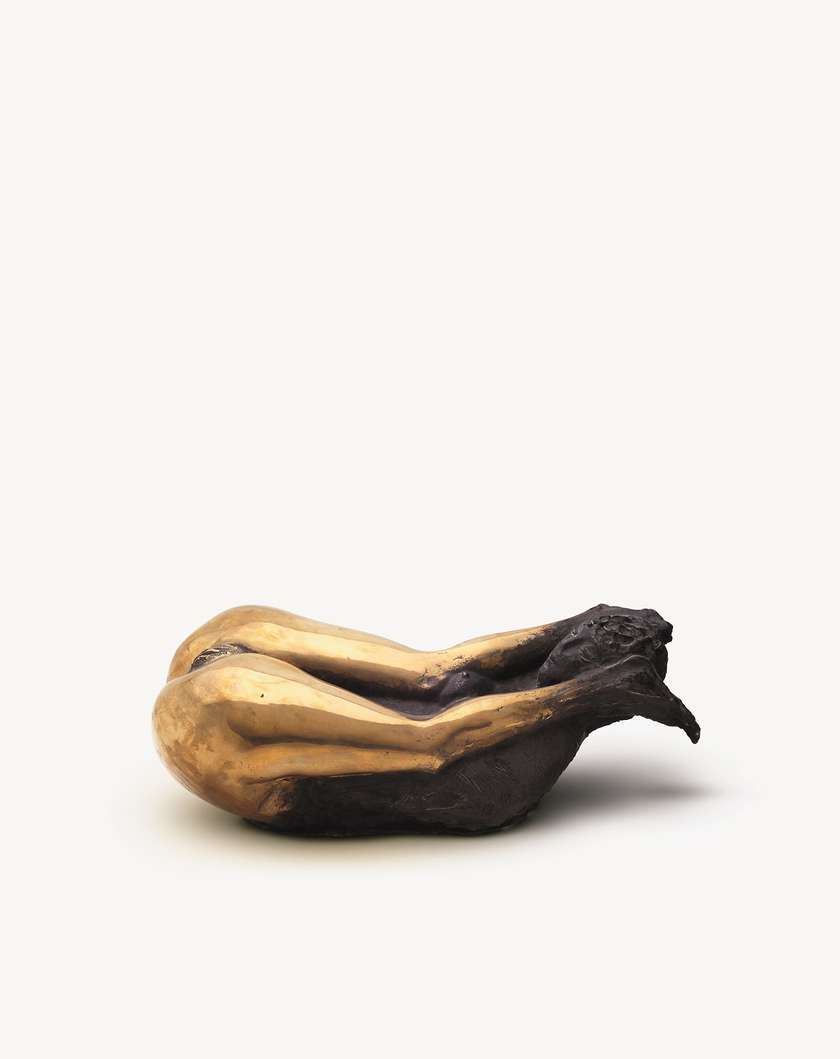
City Museum – The Museum in French Revolution Square has an exhibition on the writer Ivan Cankar that’s on until the end of February 2019, with pictures, books and manuscripts, all presented in Slovene and English. It also has a very interesting permanent exhibition on the history of Ljubljana, from prehistoric times to the present day, with many artefacts, models and so on that bring the story alive.You can read about my visit here. Until March 2019 there's a show highlighting the work Elza Kastl Obereigner (1884-1973), a pioneer Slovenian sculptress, with an example of her work shown below.
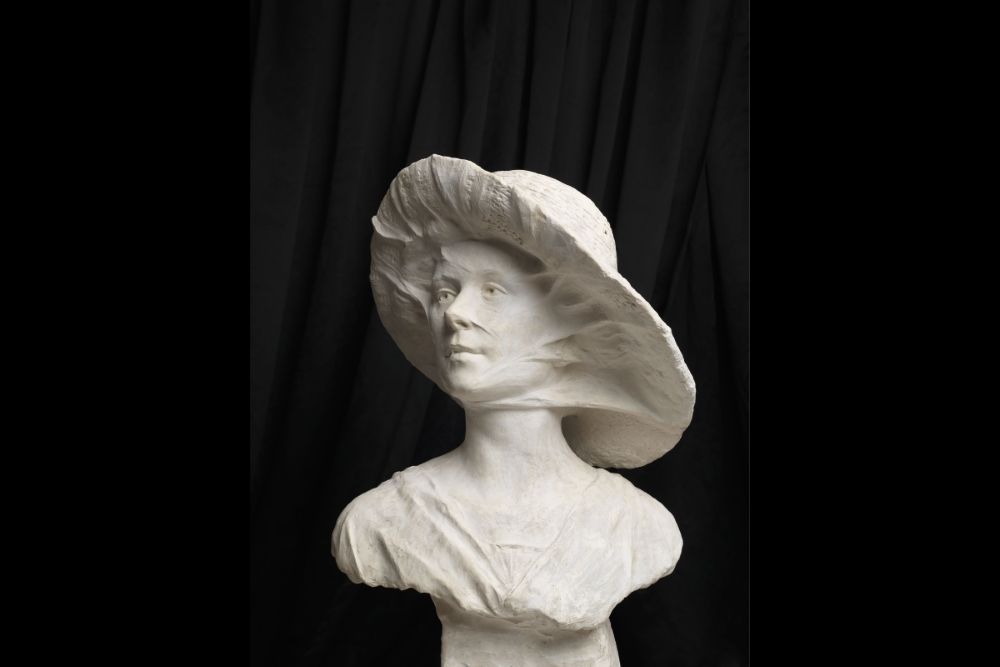
Photo: M Paternoster
The Faces of Ljubljana in the City Museum. Photo: JL Flanner
Galerija Jakopič – On until March 3 is Over My Eyes (Na moje oči), an exhibition of photographs from Iraq taken by Iraqi photographers.
International Centre of Graphic Arts – Running from Friday until March 3 2019 there will be a show of posters from Milton Glaser, while until March 3 2019 you can enjoy paintings, drawings, prints and murals from Nathalie Du Pasquier in a show called Fair Game. The latter is being promoted with the following image.
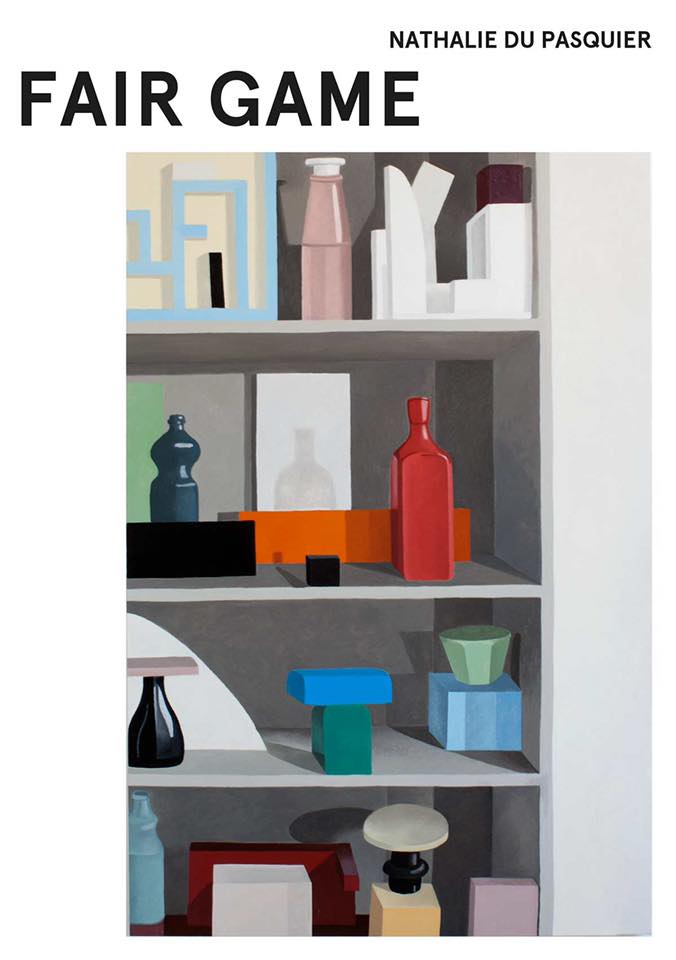
Ljubljana Exhibition & Convention Centre – Just outside the centre of town, at Dunajska cesta 18, you can see a lot of plasticized bodies at the Body Worlds Vital show, running from October 20 until January 20 2019.
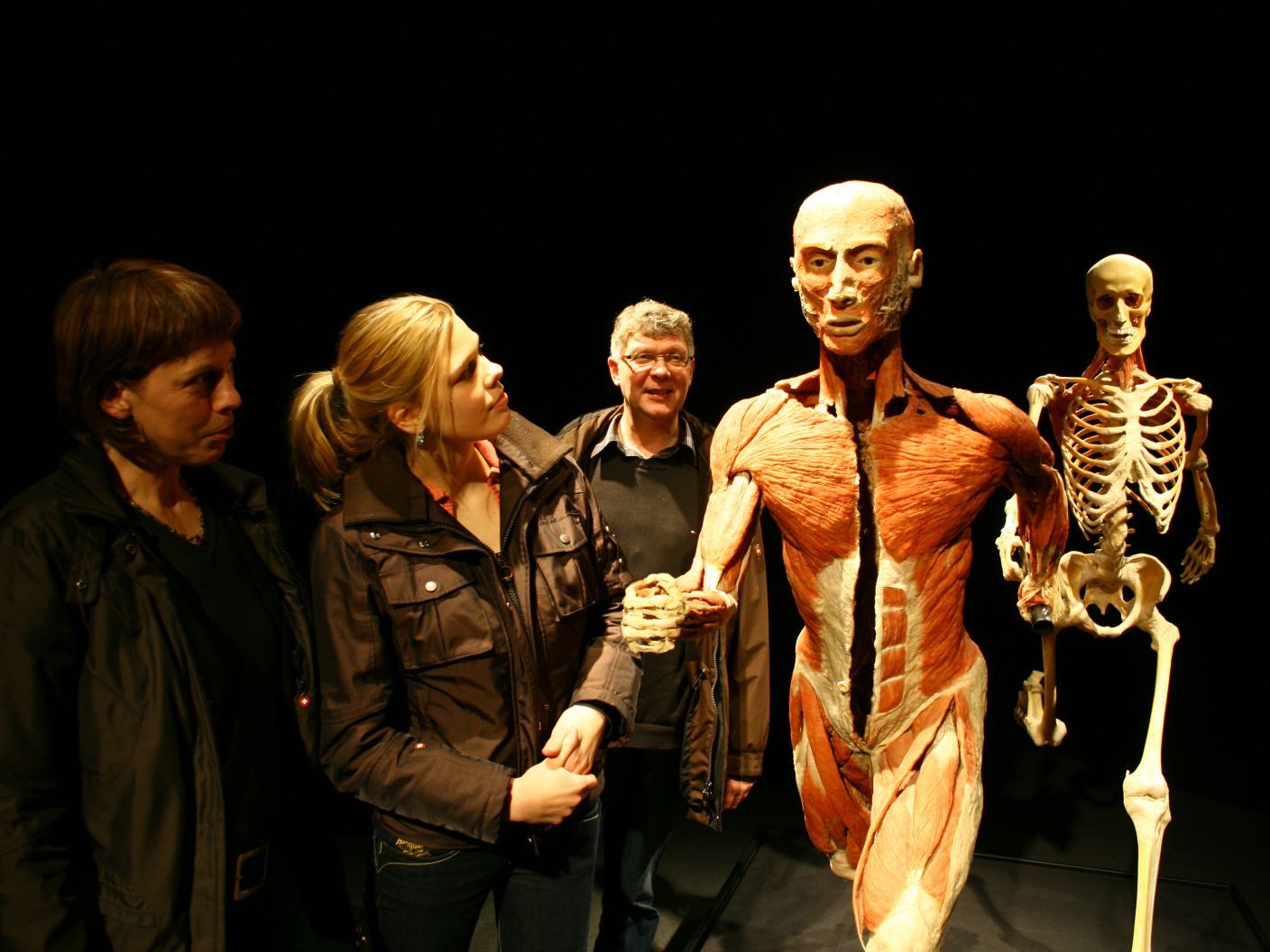
Photo: Body Works Vital
MAO – The Museum of Architecture and Design has much of what you'd expect, and until March 25, 2019, has a show on Ljubljana and it's relation with water. Until February 24 visitors can enjoy Toasted Furniture, which presents some experiments with the reuse of plastic waste, and until February 28 there's a show on Oskar Kogoj and his chairs.
Sam, 1966, fotografija na srebroželatinskem papirju. ©Stojan Kerbler
Moderna galerija – The main branch of this gallery, to be found near the entrance to Tivoli Park, has a good collection of modern art, as well a nice café in the basement.
Museum of Contemporary History – The museum in Tivoli Park has two new shows. One is called Museum's (R)evolution 1948-2018, marking the place's 70th anniversary with an exhibition tracing its evolution through artefacts, photographs and personal stories and running until January 6 2019 (details here). There's also In Search of Freedom: 1968-2018, looking at the 1968 student protests.
National Gallery – The country’s main gallery has “the best” of what’s on offer from the Middle Ages to non-contemporary modern visual arts, and is in a great location for exploring other areas, just by Tivoli Park and opposite the main branch of the Moderna galerija. Running until February 10 2019 is a show called Ivana Kobilca (1861-1926): But Of Course, Painting Is Something Beautiful!, featuring works like the one below. You can read about our visit to the room containing sacred art from the Middle Ages here, and see a picture from our trip after the two girls.
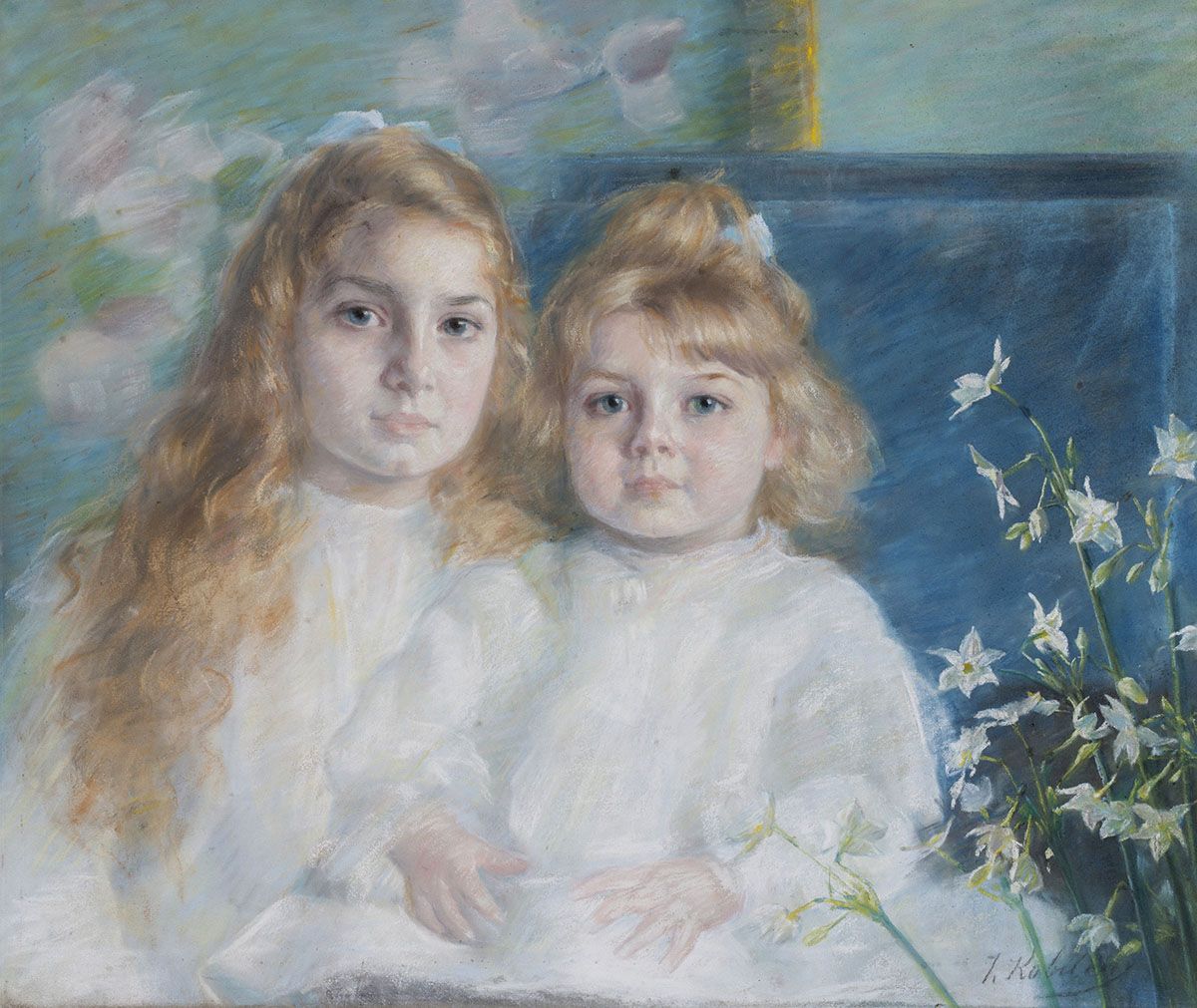
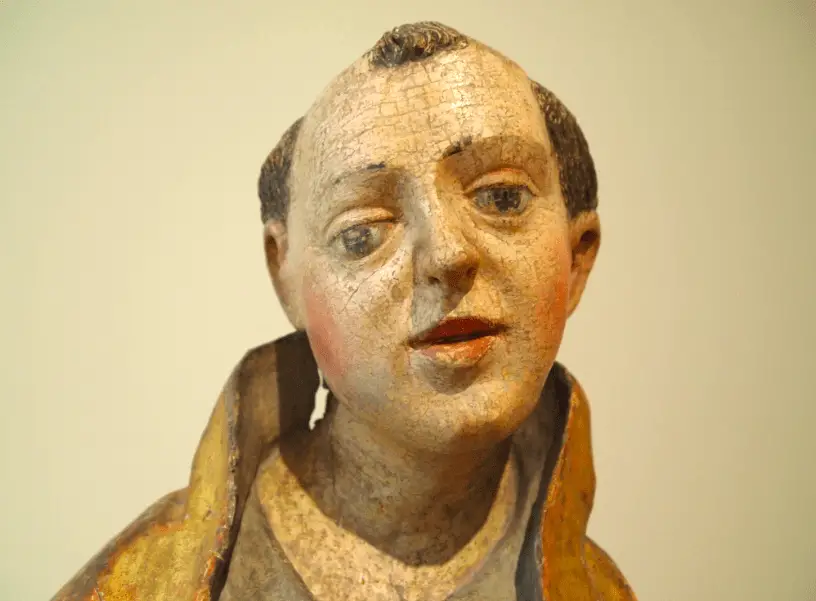
JL Flanner
National Museum of Slovenia – There’s plenty to see in the permanent collection here, from Roman times, Egypt and more, with the big draw this season being the exhibition of over 140 items of gold from Ming Dyntasy China, as reported here, and with an example below. This runs until February 15th.
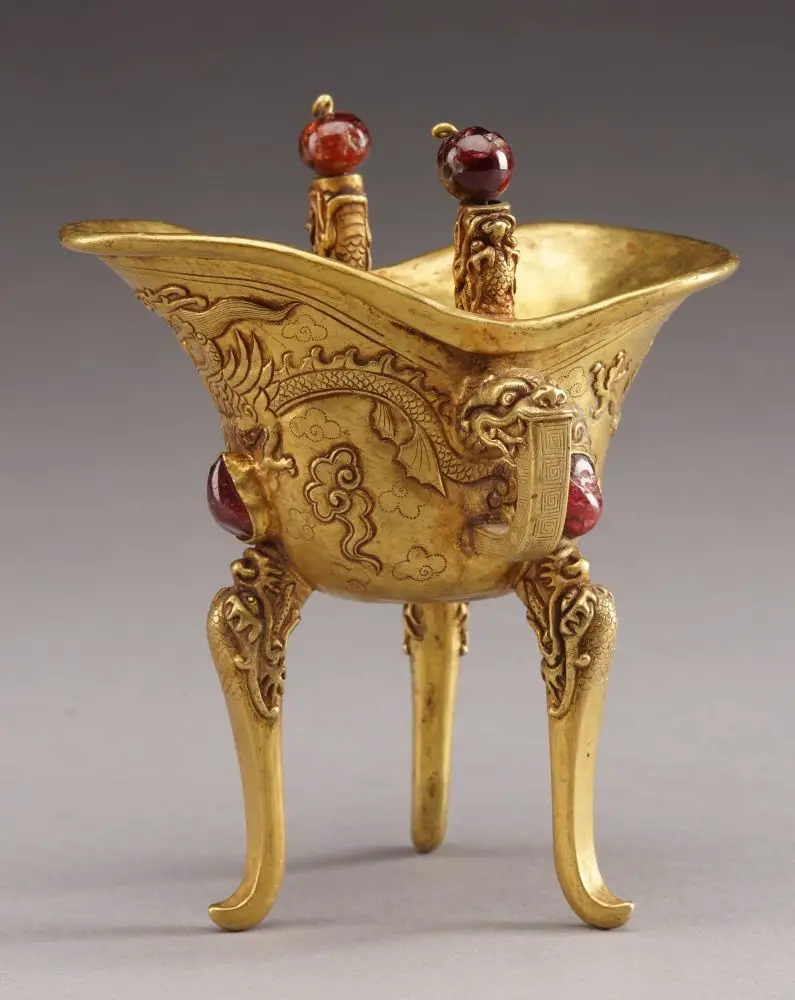
Photo: Wang Wei Chang
Meanwhile, the museum's Metelkova branch, located between one branch of the Moderna galerija and the Ethnographic Museum has some rooms on Church art, furniture and weapons, with the latter including more guns than you'll see anywhere else in town, and quite a thrill if coming from a nation where such objects are not household items.
Natural History Museum – On until the end of June 2019 is Our Little Big Sea, which takes a look at the oceans.
Škuc Gallery - You can find this in the old town, and until January 20 there;s an interesting and often moving show called Kids that you can see for just 1 euro, with works by Johanna Billing, Matic Brumen, Andreja Džakušič, Priscila Fernandes, Eden Mitsenmacher, Franc Purg, and Pilvi Takala.
Slovene Ethnographic Museum – The museum currently has a temporary show on Bees and Beekeeping, on until June 16 2019, as well two permanent exhibitions. One of these is called Between Nature and Culture, and has a great collection of objects from Slovenia and around the world, well worth the trip up to the third floor to see it (as recounted here). This place is located near the newer branch of the Moderna galerija and Metelkova.
Union is "the Ljubljana beer", but now both it and Laško are owned by Heineken. There are many local brews on offer around town, though, if you want to explore IPAs, stouts, wheatbeers, sours and so on Photo: JL Flanner
Union Experience – The Ljubljana-based brewer has a museum showing the history of the company, with the ticket also including access to part of the factory and a few samples of the product. You can read about our visit here.
It's not a formal museum, but if you're interested in "Yugo-stalgia" then you'll enjoy a trip to Verba, a small, privately run space that's crammed with objects and pop culture items from the era, and is conveniently located at the start of one of the short walks to the castle. It's also a great place to take pictures, if you leave a donation, and you can read more about it here.
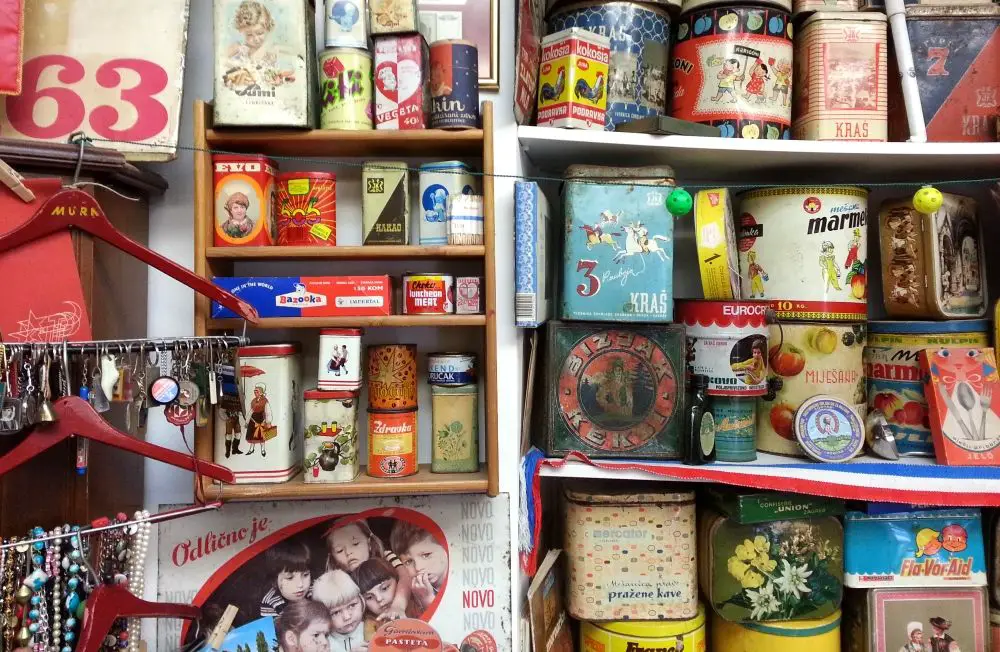
Verba. Photo: JL Flanner
Alternative Ljubljana isn't a museum or gallery, as such, but instead turns the city streets into a museum and gallery. Learn more about their tours of street art, history and LGBT Ljubljana here.
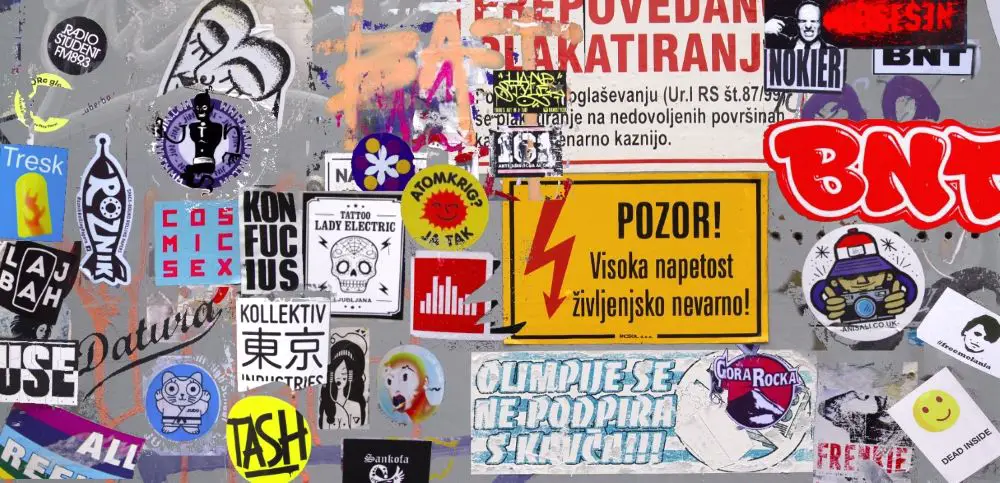
Photo: JL Flanner
Other things to do in Ljubljana...
If you'd like to spend an evening painting with others, then take a look at Design with Wine, which organises painting parties on Trubarjeva cesta,
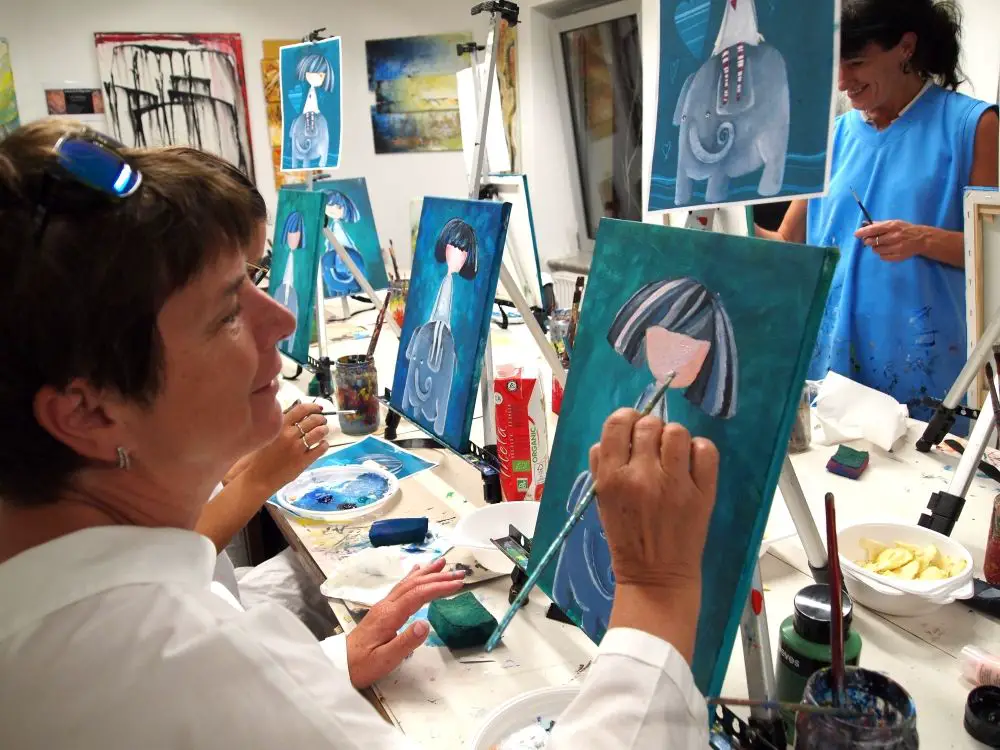
If you want to see some antiques, then check out the wonderful Antika Carniola, as discussed here. The man behind it, Jaka Prijatelj, has a fine eye for life on this street, as you can see on his Facebook account.
Photo: JL Flanner
If you’re in town and want to go jogging or walking in nature, why not take another look at the Castle, with a brief guide to the trails here. If you want something bigger, head to Tivoli Park.
And if you're bored with the Old Town, why not take a walk, cycle or boat ride to nearby Špica and enjoy the riverside life. Learn more about that here.
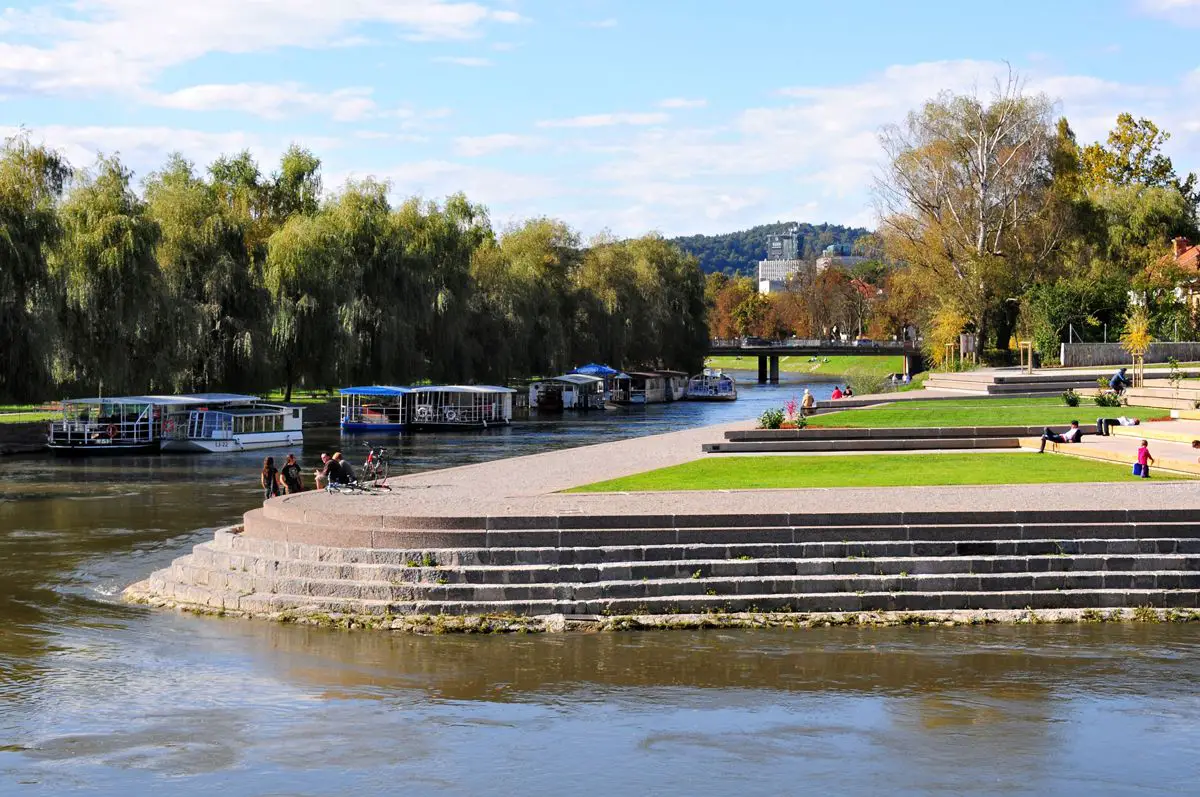
visitljubjana.si
![]()
maxpixel.net, public domain
Want to stretch and breath? Then check out our list of drop-in yoga classes for tourists, visitors and the uncommitted. If you're heading to the coast, check out our interview with a yoga teacher who offers breakfast sessions there, while if you're staying in town (or nearby) and want to try some "family yoga" then you can learn more about that here and maybe get your kids to calm down a moment or two.
There are some golf courses near Ljubljana, but even ones further away are not far, as seen in our list of all the golf courses in Slovenia. Note that these close when the snow starts, if it ever does this year, in which case you might be interested in what's new at Slovenia's ski resorts for 2019, as reported here.
![]()
Photo: maxpixel.net, public domain
Daytrips from Ljubljana
Most of Slovenia is only a few hours from Ljubljana, and you can easily visit Lake Bled, Lipica Stud Farm, Postojna Cave, Predjama Castle, the coast and other locations, while if you'd like to take a photo of from that bench in Bled, then you can learn how to get there here. If you’re looking for something more ambitious, then check out our recent guide to the 17 members of the Association of Historical Towns of Slovenia
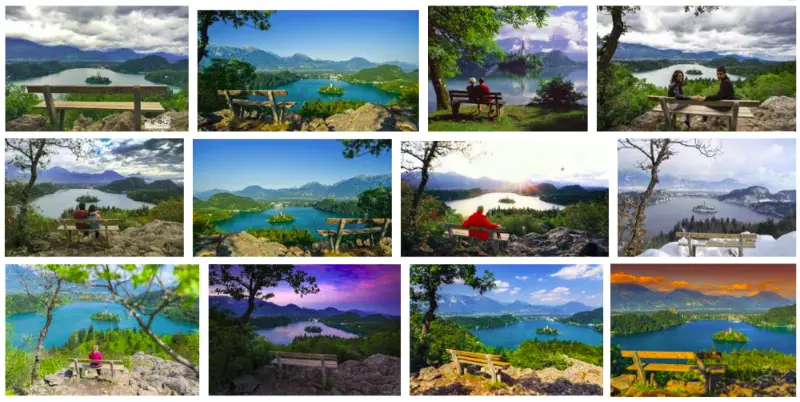
Photo: Google Image Search
Finally...
1. You can see all our stories tagged Ljubljana here
2. We found ourselves with friends in Ljubljanski Dvor for pizza this afternoon and had forgotten about the raw size, majesty and value of their 50cm pizzas, which math says is an incredible 1,963 cm2 of flat surface, or somewhat more due to the uneven nature of the actual “pie”. See a write up of an earlier visit here.
STA, 11 January 2019 – Gynaecologists (ginekologi) in Slovenia have too many women enlisted as their patients, which leads to lower-quality examinations and longer waiting times. They thus urge authorities to reduce the number of women per gynaecologist to preserve the achieved high level of gynaecological care.
Medical Chamber representatives told the press in Ljubljana on Friday that a shortage of gynaecologists and ever new generations of women entering the system had affected access to gynaecologists.
They believe at least 30 new gynaecology teams would be needed to cope with the shortage and take the pressure off overburdened gynaecologists.
In 2018, a gynaecologist had an average of 4,800 women enlisted as their patients, while the college of gynaecologists and obstetricians maintains 4,000 would still be an acceptable figure.
However, some gynaecologists had even more than 7,000 women enlisted, explained Domžale Medical Centre gynaecologist Petra Meglič, who treats some 6,200 women.
All women, including girls aged at least 13, are entitled to choose their personal gynaecologist in Slovenia.
Since some 700,000 women have their personal gynaecologist, gynaecologists carry out more than 1.5 million medical examinations a year.
Another burden is a number of administrative tasks gynaecologists are obliged to carry out, which further shortens the time they have for their patients.
An aging and shrinking profession
Gynaecologists are, moreover, getting older; in 2017, out of a total of 361 active gynaecologists, 160 were older than 50 and 82 older than 60.
Some 300,000 women could remain without their personal gynaecologist due to retirements in the coming years.
"Young specialists prefer to work at hospitals, as working in a gynaecology office is extremely specific, with constant high pressure to process a mass of women," said Meglič.
She also said her office rejects 10 to 20 women who have not yet chosen their personal gynaecologist a day.
According to gynaecologist Renata Završnik Mihič, young doctors are eager to specialise in gynaecology, yet not enough residencies had been opened over the past years to make up for the shortage that would stem from retirements.
The system is working only because gynaecologists assume ever more work, which leads to burn-out.
They thus called on authorities to overhaul the standards governing the number of women patients per gynaecologist, which were adopted in 1994, taking into account population ageing and new discoveries in medicine.
In this way, the country will preserve its quality gynaecological care, few unwanted and teenage pregnancies, relatively few abortions and a low rate for cervix cancer.
Moving to another country is often a difficult process, as you go through the stages of honeymoon, frustration, adjustment and acceptance, learning how to not just live but thrive in a new environment. Natasha Villone is someone who knows this well, having been born in Orel, Russia, and made new lives in the US and then Slovenia, where she’s now based in Koper and works as an artist – selling her works, teaching and leading art tours. We got in touch with her to learn more about her journey, and she was kind enough to send back some answers.
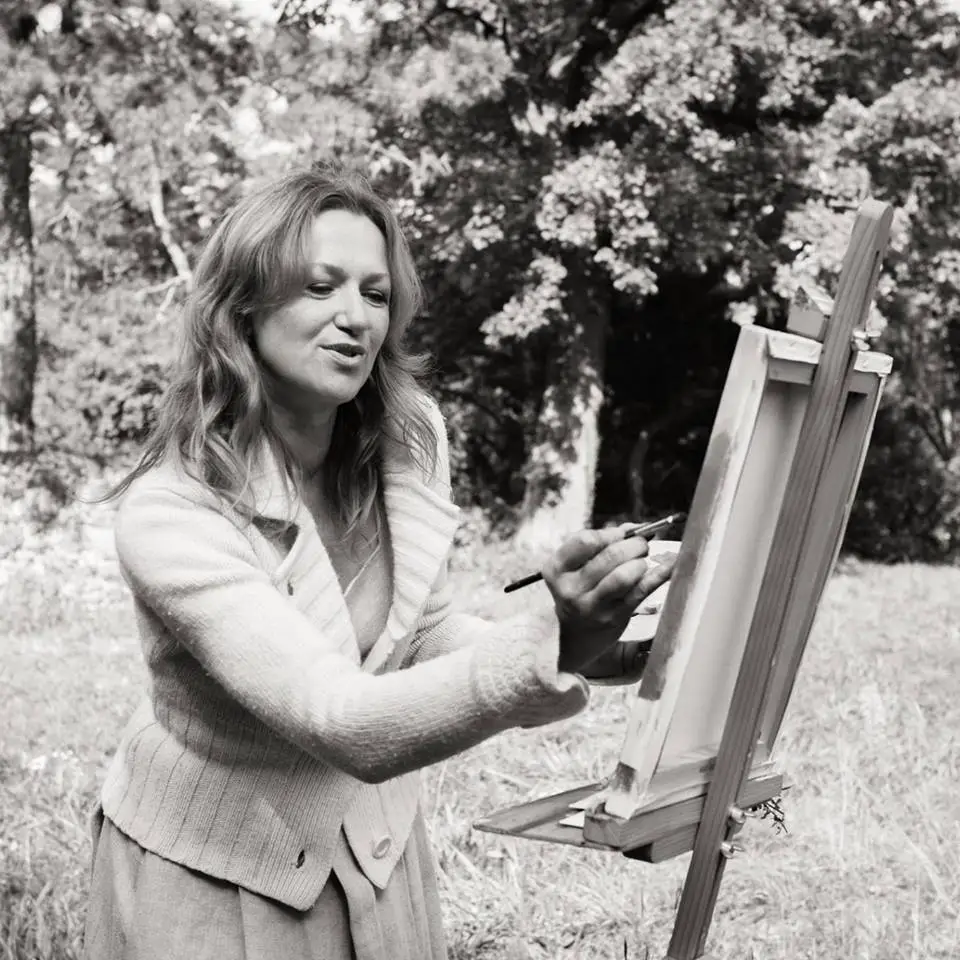
Natasha, painting
You work as a painter. When did you first get serious about art?
Since childhood the easiest and most natural thing for me to do was to paint. In spite of this, when I young, after high school, I wanted to run away from carrier as a painter. But my mom, a very wise woman, secretly signed me up for art collage, where I got diploma in theatre design.
Back then in Russia after me and my classmates graduated we were supposed to work by college referral in some type of village theatre or community club for a minimum of three years. I refused, and in order to stay in a city I took a job at the famous tray and samovar (Russian teapot) factory “Zostovo”. I painted traditional decorative trays with bouquets of roses. Later in my art life I’d use principals which I learned at the factory: volume, perspective, range of colours. But at the time the production line job and constant paint under my nails made me want to be somebody else.
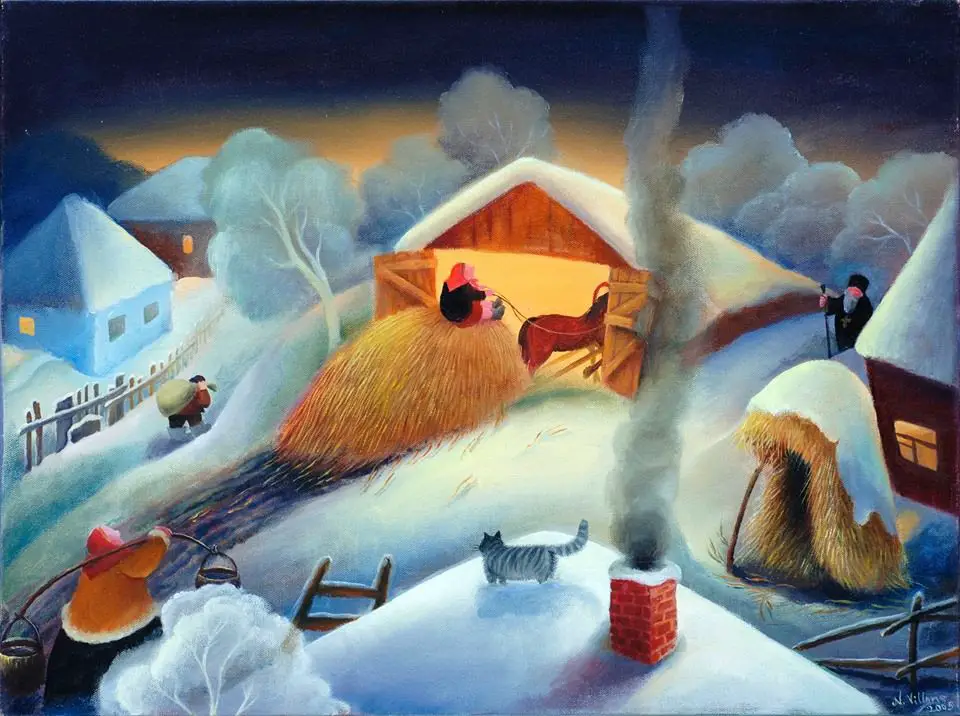
Then the Soviet Union broke apart. Russia was under President Yeltsin everything went upside down with jobs, morality, values. The factory was closed and I was left with no direction. Maybe it gave me push to look for new life abroad.
In 2001 I finally moved to America, Seattle, hoping the grass was greener there. Then in the same year September 11 happened, followed by an economic crisis. I had to do many hard jobs, and wasn’t sure that I could paint again, so I changed direction and tried something different, not just to become an artist.
But ability and desire to create were still inside me. Once at church I heard the pastor say that it’s sin to bury your talent. There’s that story in the Bible about a servant who buries the talents (money) that his master gave him to make a profit on. He was afraid to use the money and so returned it without any gain, but the master wasn’t happy at all. It was this message that pushed me to start painting again.
I’m thankful to my husband Andrew, too, about this. Many times he would walk into galleries, meet the owner, talk about me, and I would have a show there. It’s very important if your spouse supports you, promotes you, or lets you know if you’re not producing enough art, or too much art, and not marketing it well. In this business being a good artist is just 10%, the other 90% is your character not giving up, and knowing how to present yourself to the public.
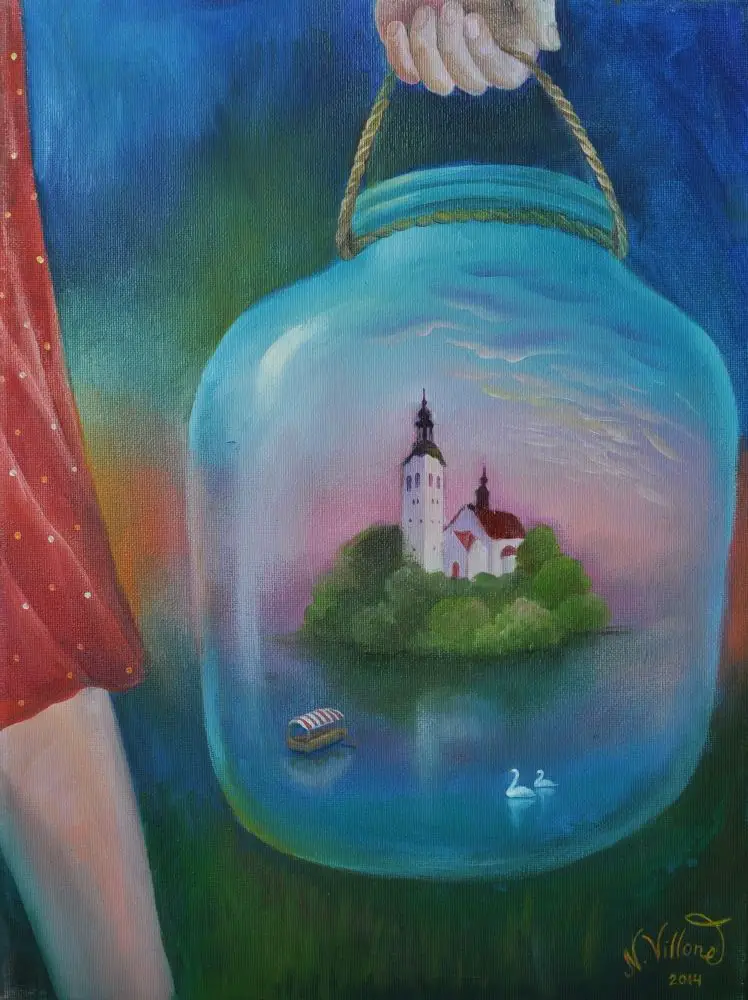
How did you end up in Slovenia?
While living in America, my husband started running a tourism business in Slovenia. Flying back and forth between the two countries was too hard. I remember one day he said: “Prepare yourself, you have one year, then we’ll move to Slovenia.”
By this time we had two little kids. I was working for good company. My mom from Russia was living nearby and helping with the kids. Art was my second freelance job sometimes in a evening. And now I have to quit my stable job, leave my mom, take kids and follow my husband. Women would not do it, only man could do such a crazy but maybe strategic decision . To be honest, I cried a lot saying goodbye to everything after 14 years establishing my life in America, hoping for some kind of change in our plans.
We finally did it in 2014, and things went smoothly, step by step. We even managed to get on the show “House Hunters International”. God thus made some fun for us, so we wouldn’t be sad just after cutting off our roots in Seattle. People where recognising us from that show for several years, even in Slovenia, so now we know what celebrities feel when they don’t want to be recognised.
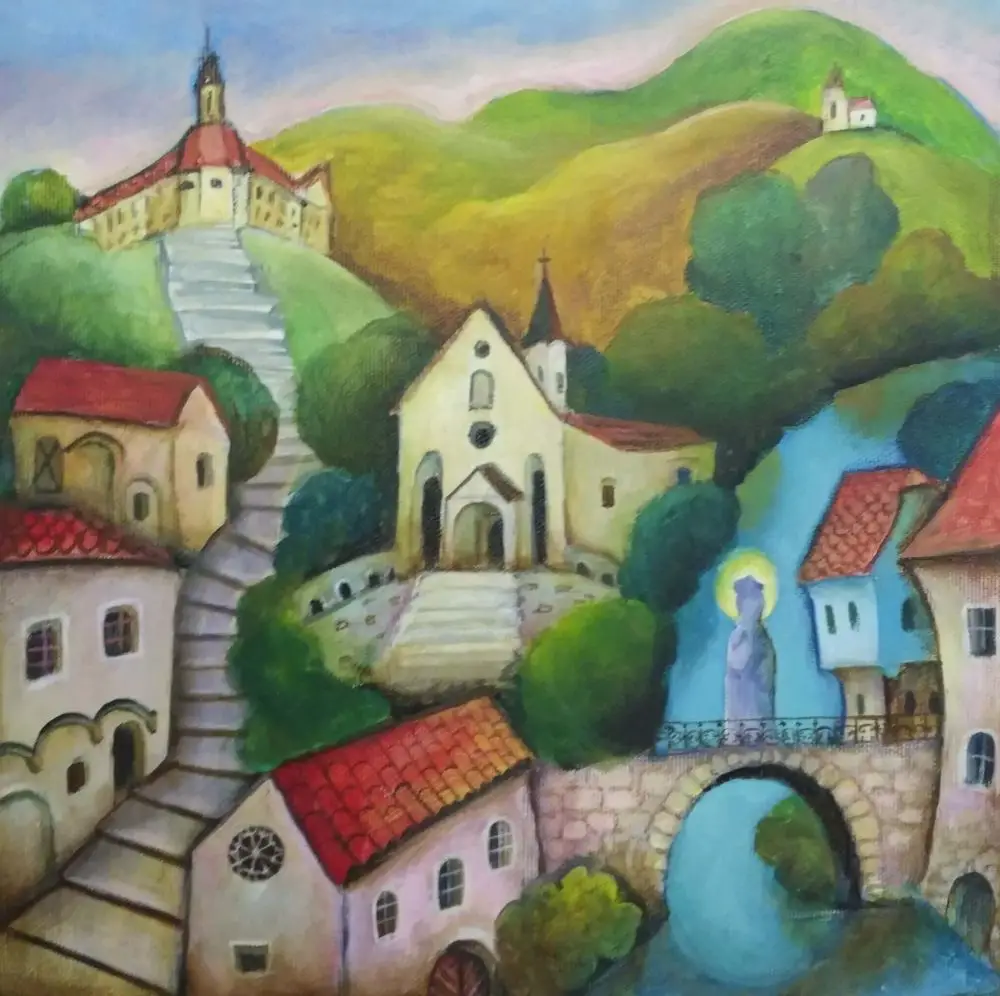
How did you make the move to art here?
In Slovenia I’m wasn’t looking for an office job, because of the language, so art became my priority. Living in Europe helped me travel more, exhibit and sell my art. In 2016 I won the grand prix in the biggest European festival of naïve art, held in Poland. Last year I published my first children’s book Repa velikanka (The Giant Turnip). Perhaps it’s little easier here than trying get lucky with a New York publisher
Unfortunately it’s hard to sell anything in Slovenia, especially art, unless it’s very cheap. But still I’m very thankful to be able to paint. I always tell my students in the adult classes I teach that when you create you never feel lonely or old, you will not be afraid to be left without job, or to retire. It’s like you’re hiding away in a magical world full of new adventures. Yes of course sometimes you struggle, sometimes your idea reveals itself through an image easily. You never know. My only complaint is that I don’t have enough hours in a day to find some extra time to paint among my routine of being housewife with two kids.
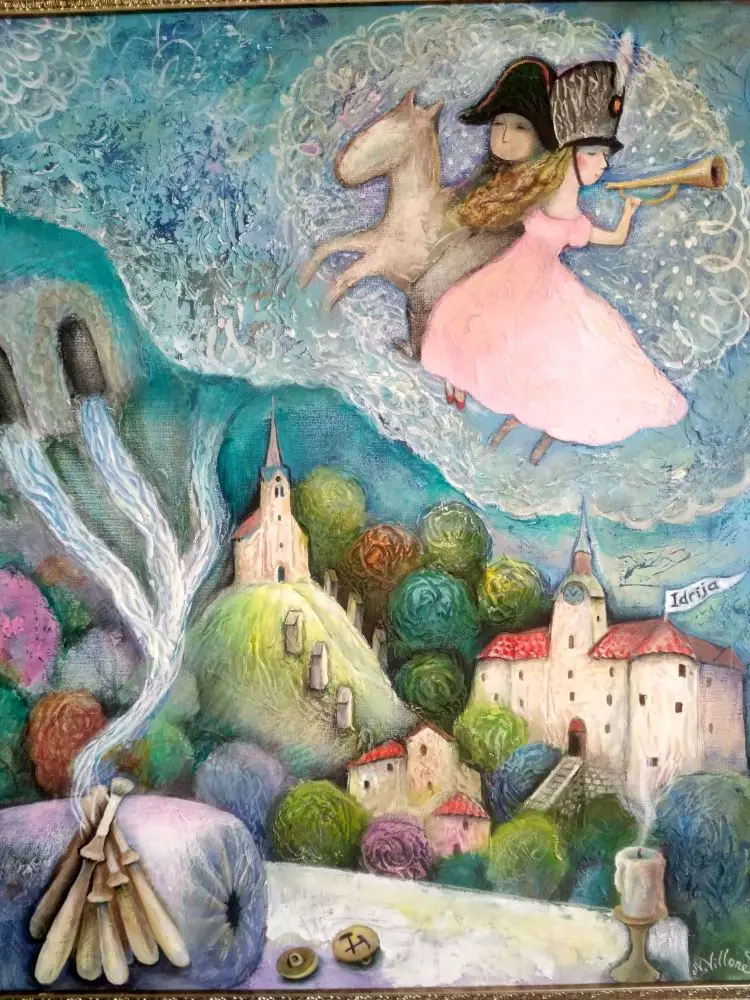
Tell us something about the art tours you run.
As I said earlier, my husband works in tourism, organising food tours of Slovenia, so we started running art tours together. It works perfect between us. He’s the organiser and driver, and then while I’m doing the workshops he’s taking a nap.
We do a seven-day art tour that’s suitable for everybody: from beginners to experienced painters. On the tour you learn a few painting techniques and some tricks from me, so you can create art which looks look deep, textural, and a little vintage.
We choose the most picturesque places to do workshops in the open air. So Lake Bled, the vineyards of Brda, and in Piran, on the Adriatic coast. On a tour we paint, hike, eat homemade food from the local farms, and learn the recipes in a cooking class. There’s also wine-tasting in vineyards, and trips to an olive garden and other farms. You can find out more at my website.
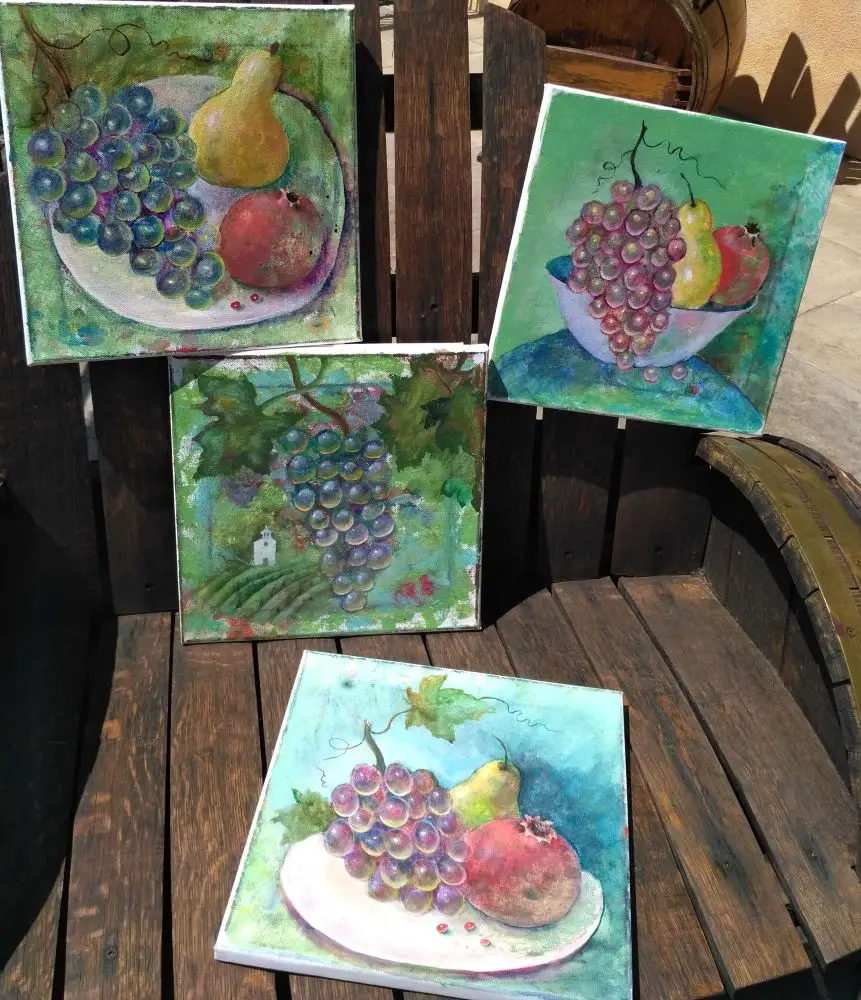
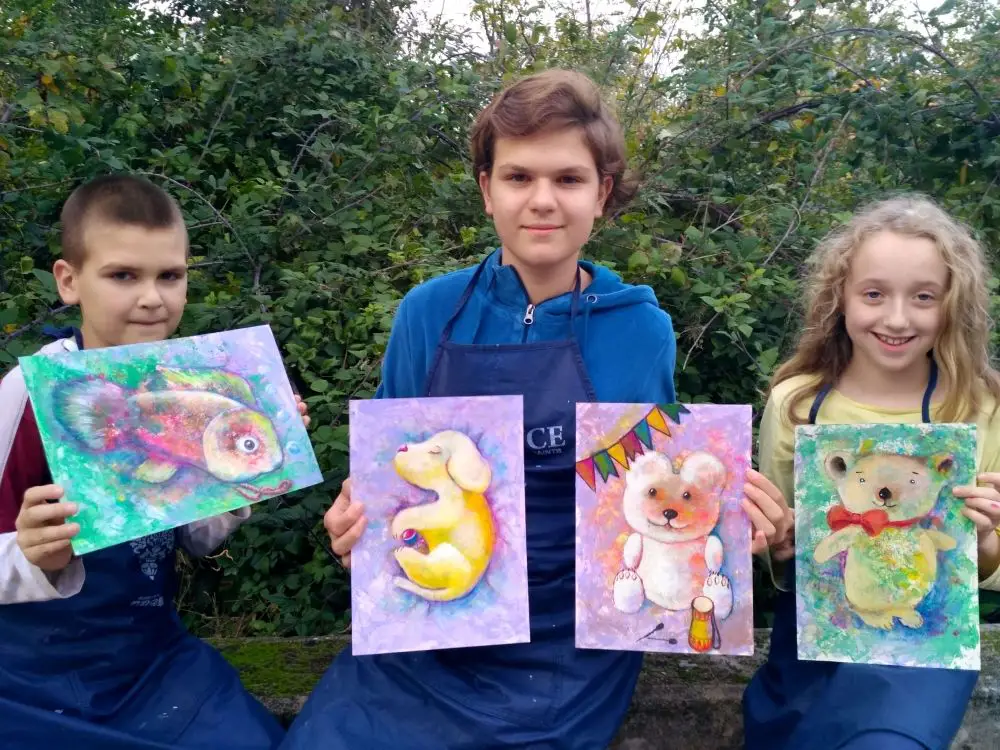
What are your plans for the future?
Nowadays we live in Koper. Watching the sea, boats and cruise ships cheers me up and gives me new ideas for paintings. My hope is to find place and start exhibiting my art in Slovenia this year, so I can invite your readers to a show. Now I’ve been here a few years I’ve painted lots of Slovenian places, like Bled, Ljubljana, Škofja Loka, Idrija and others. My style is what they call naïve. I see things figuratively, symbolically – combining reality with imagination.
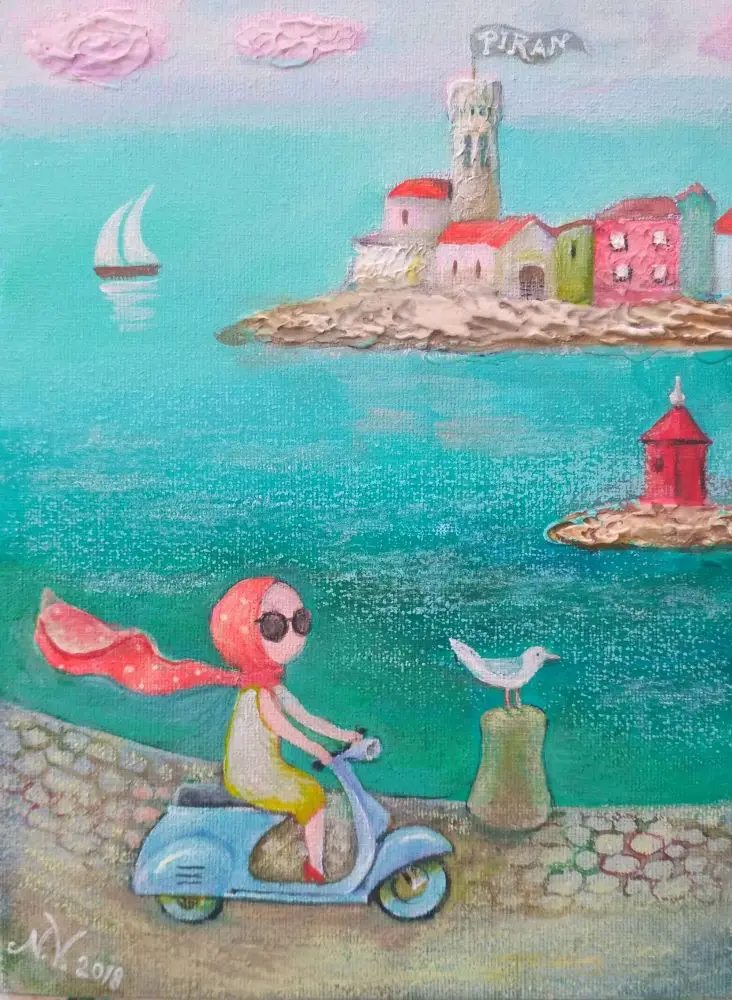
If you’d like to see more of Natasha Villone’s work or learn more about her tours then you can do so on her website, Facebook, or Etsy page, and if you’re in Koper you can sign up for one of her weekly workshops, which happen every Thursday, by sending an email to This email address is being protected from spambots. You need JavaScript enabled to view it.
And if you'd like to share your story with our readers, then please get in touch at This email address is being protected from spambots. You need JavaScript enabled to view it.


